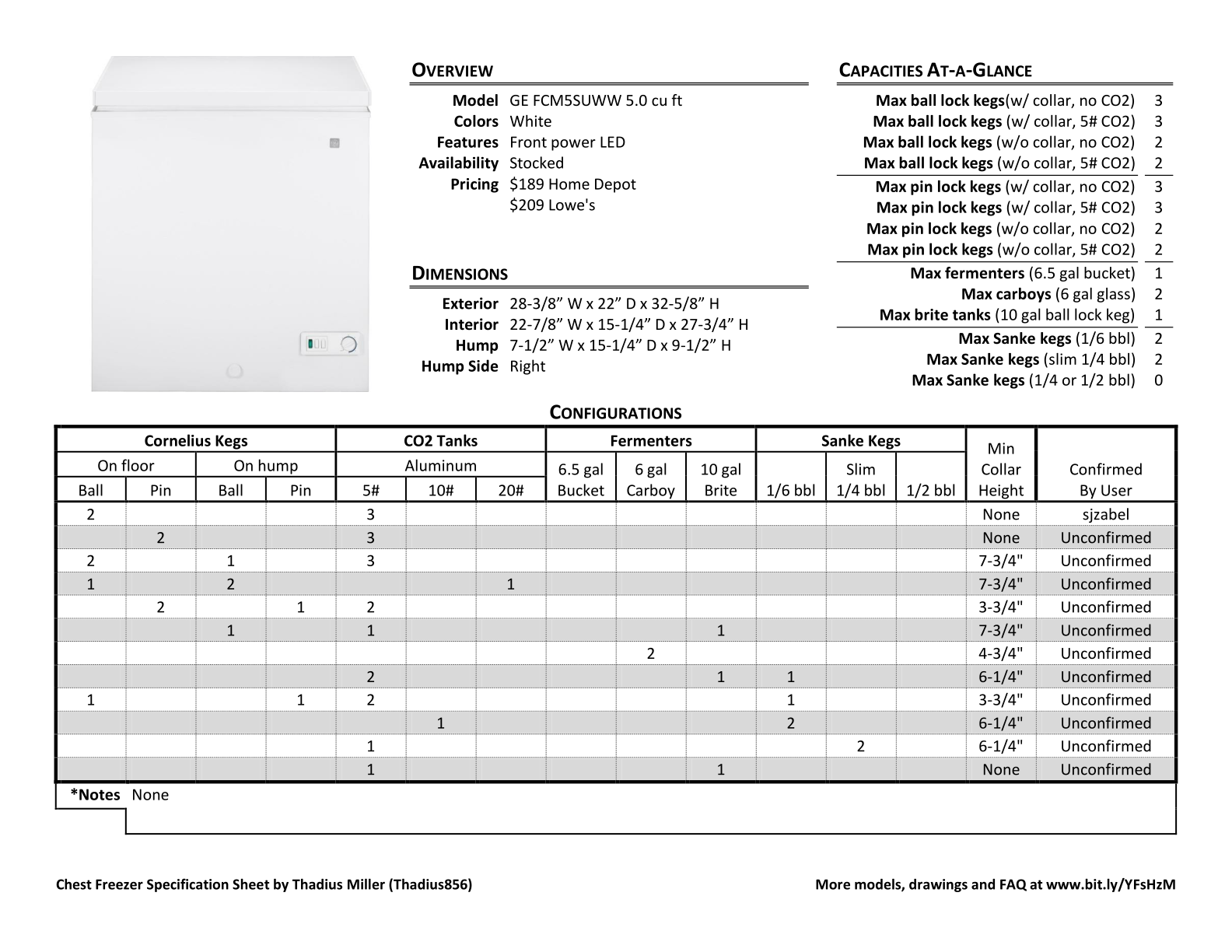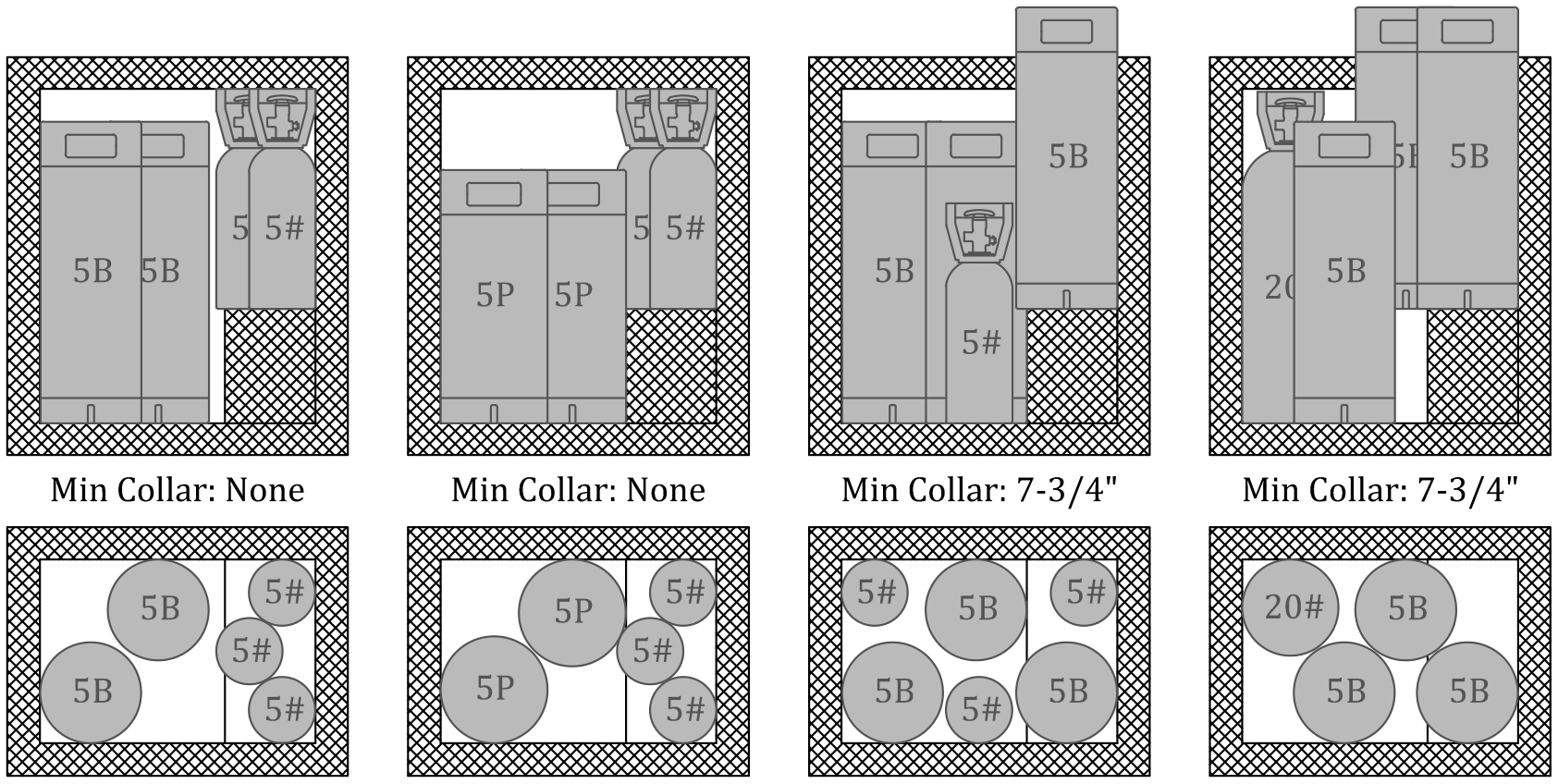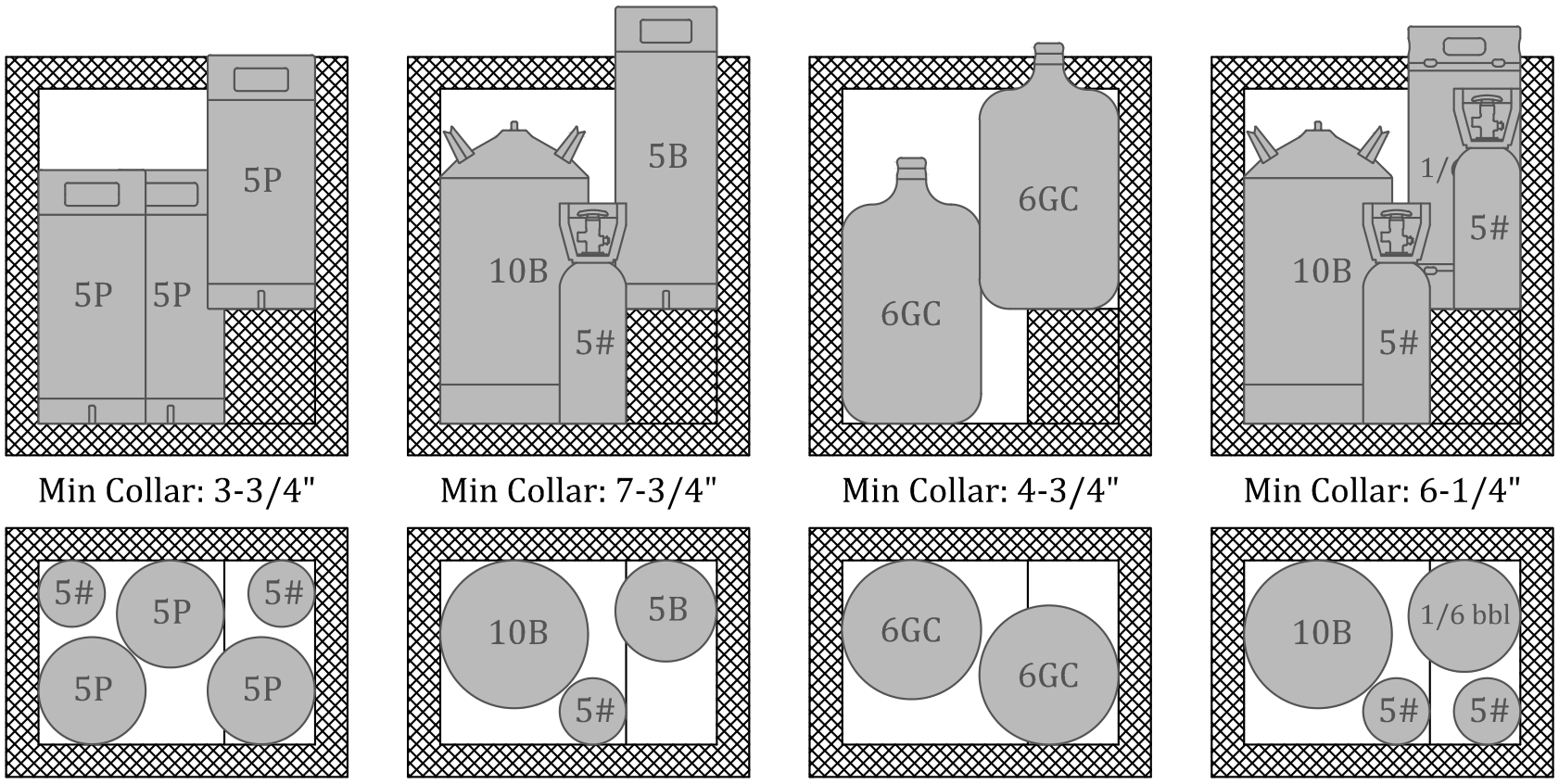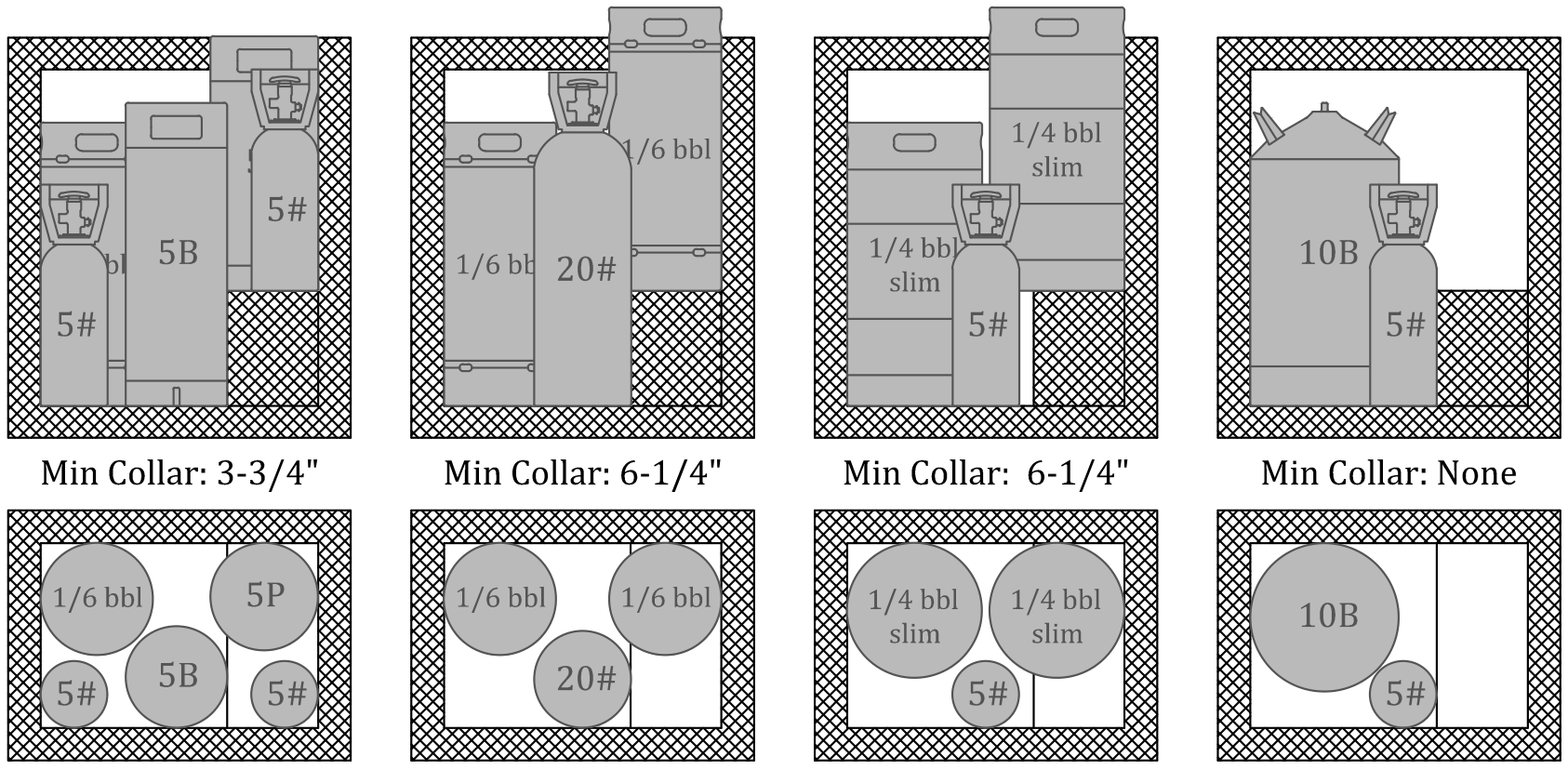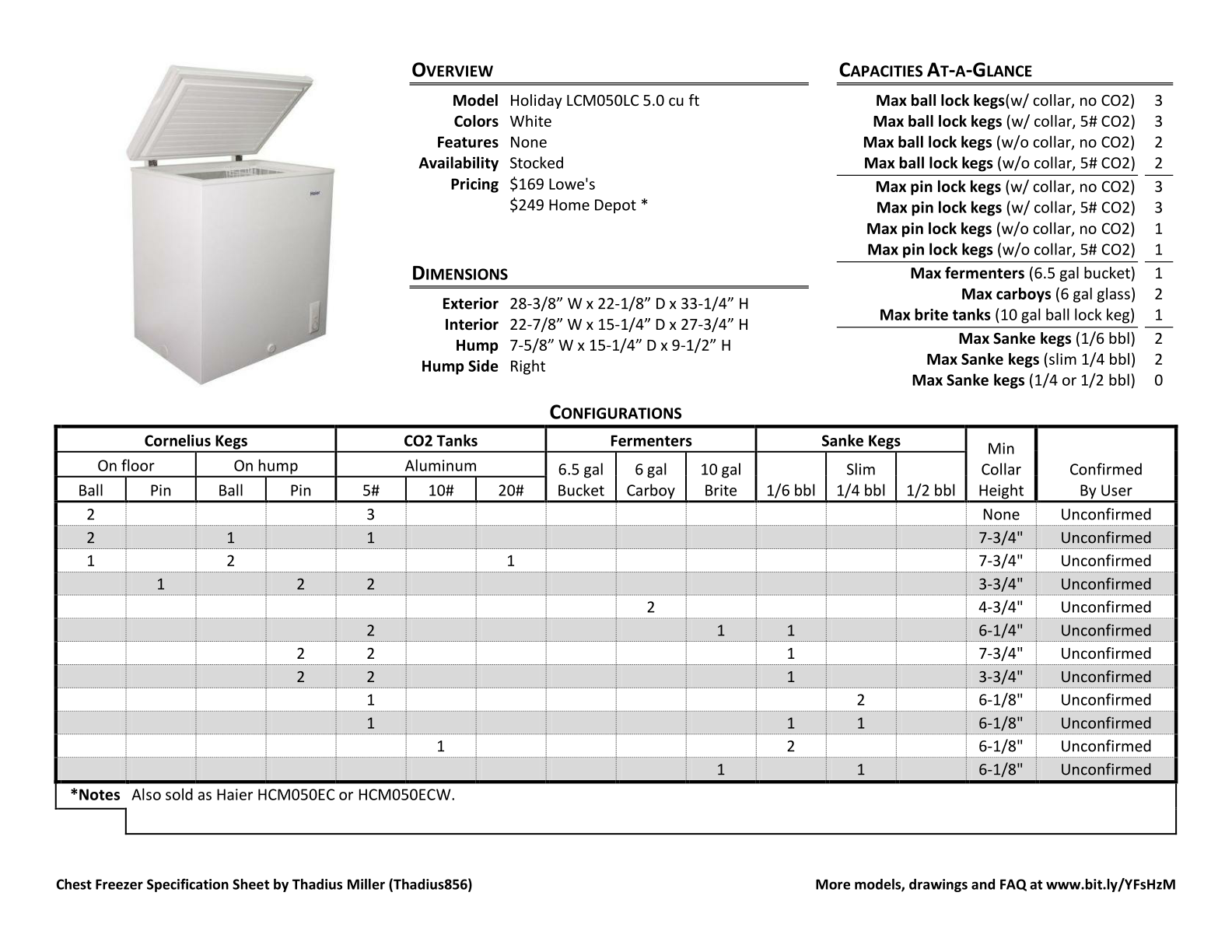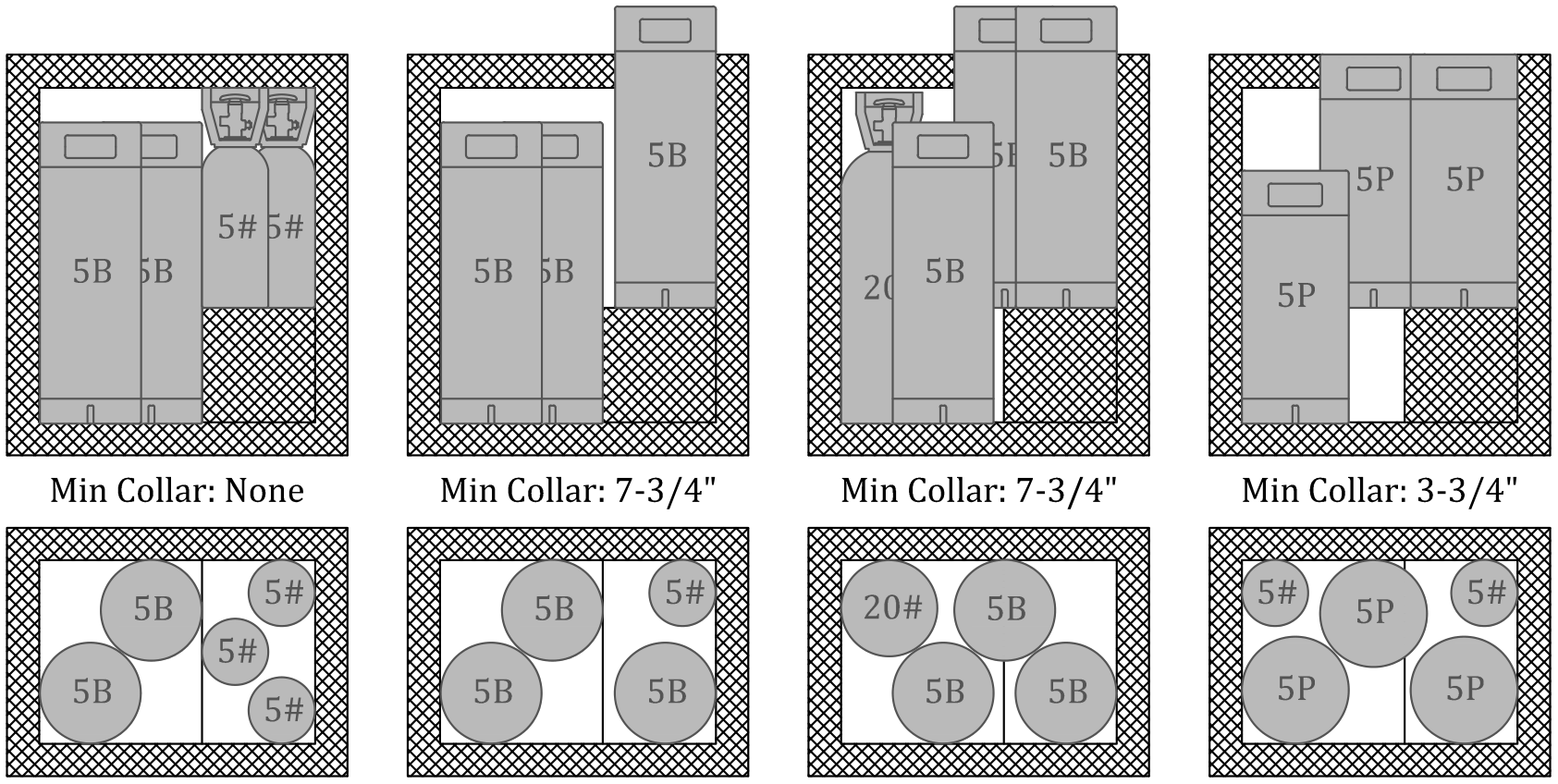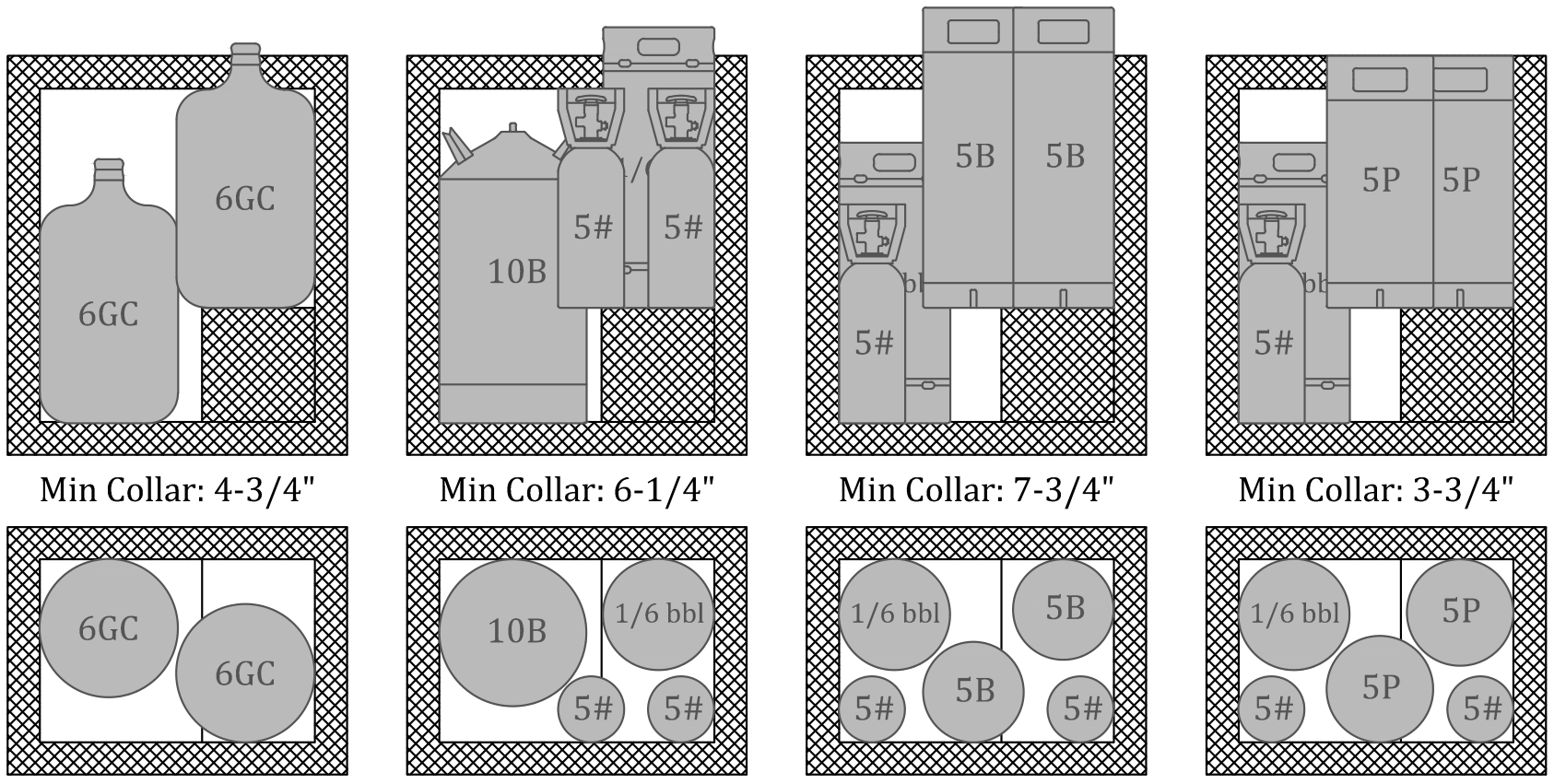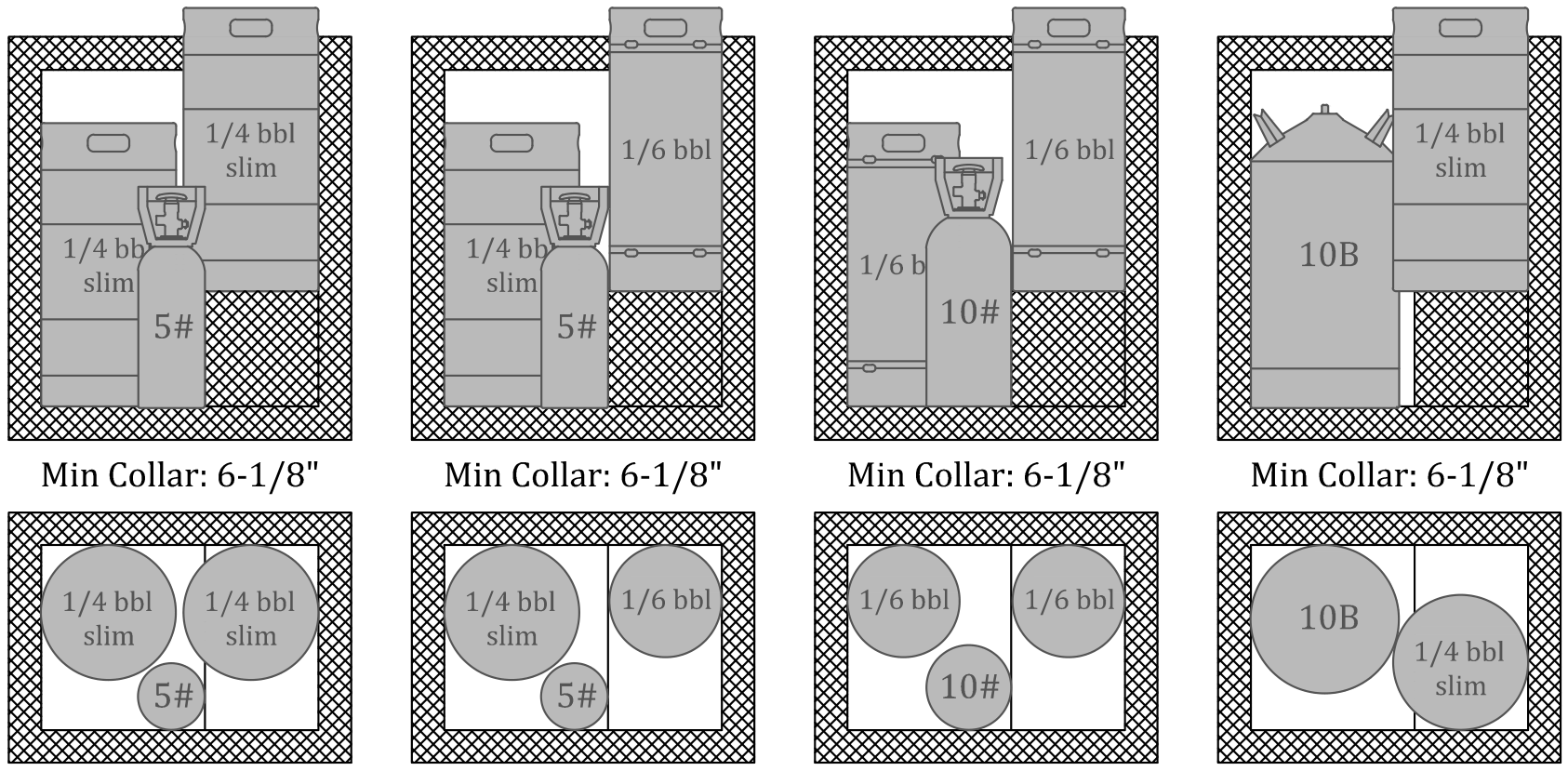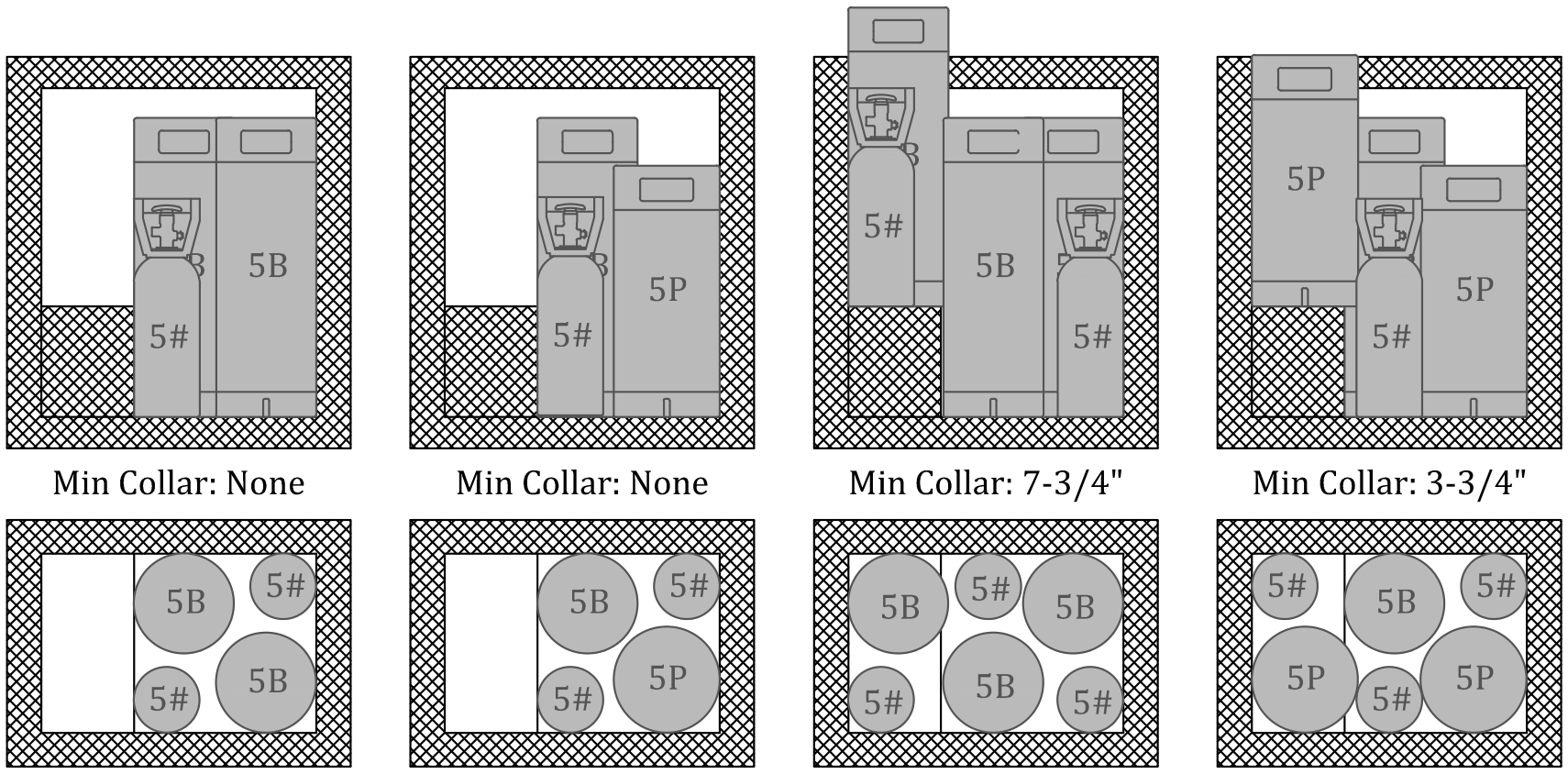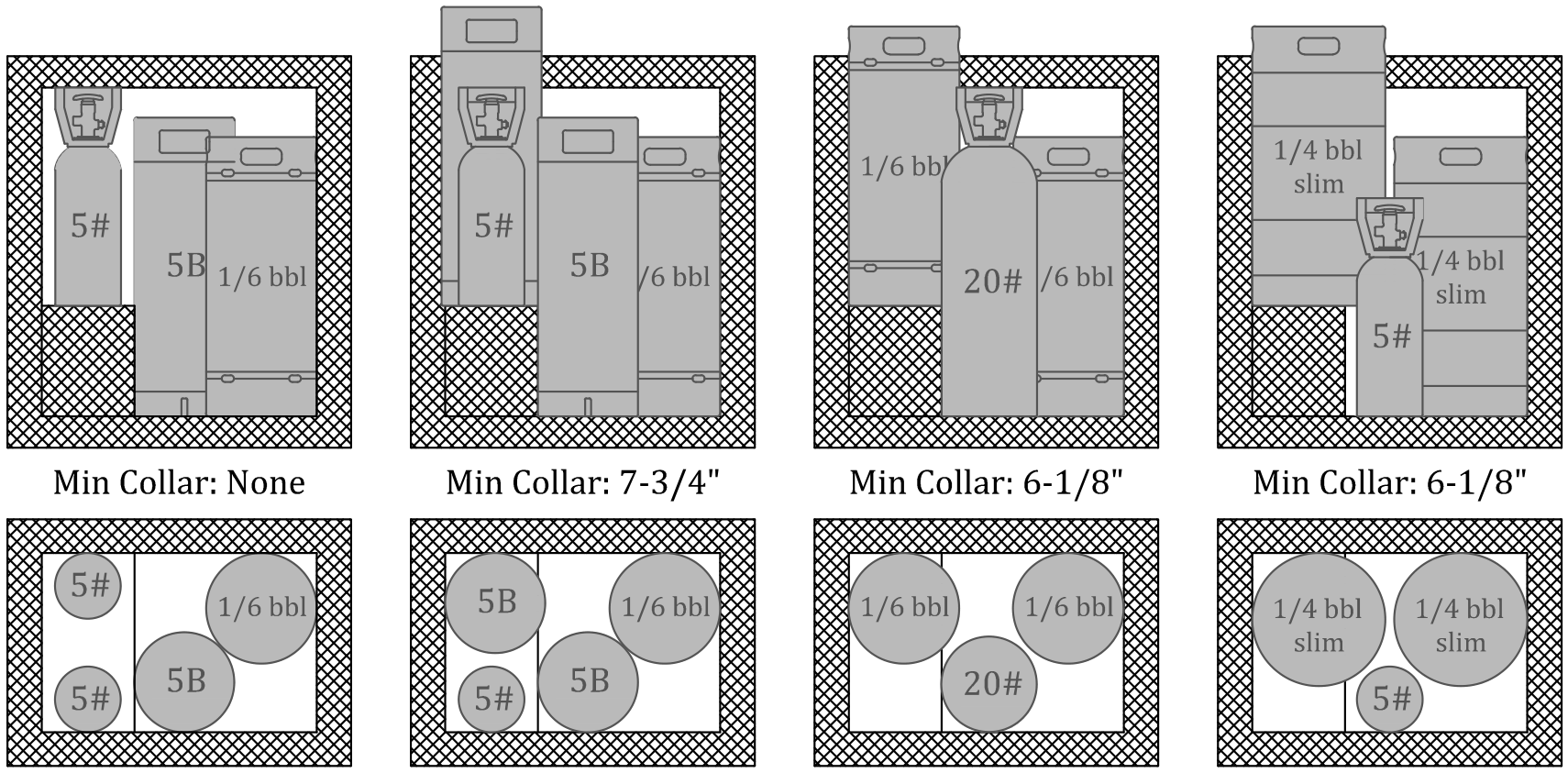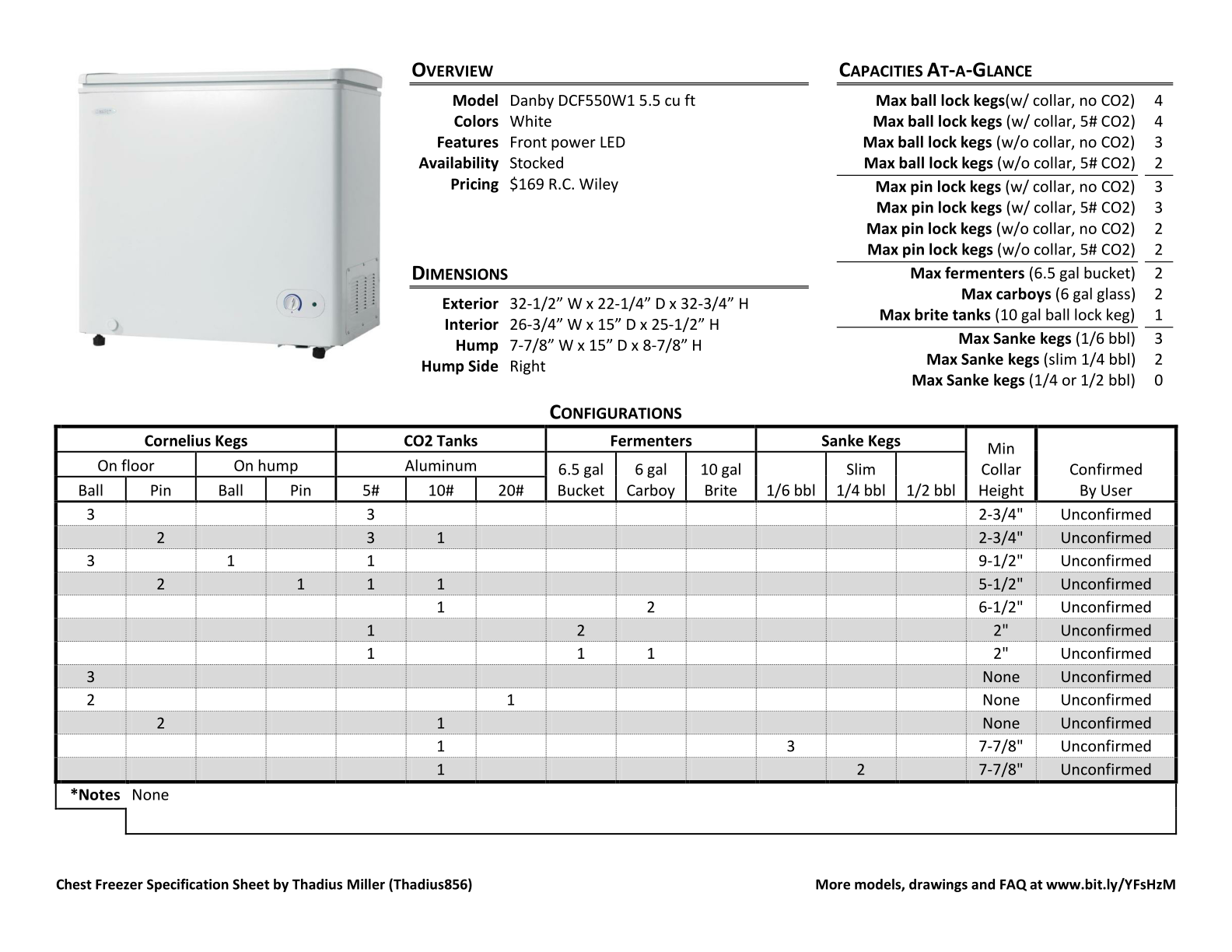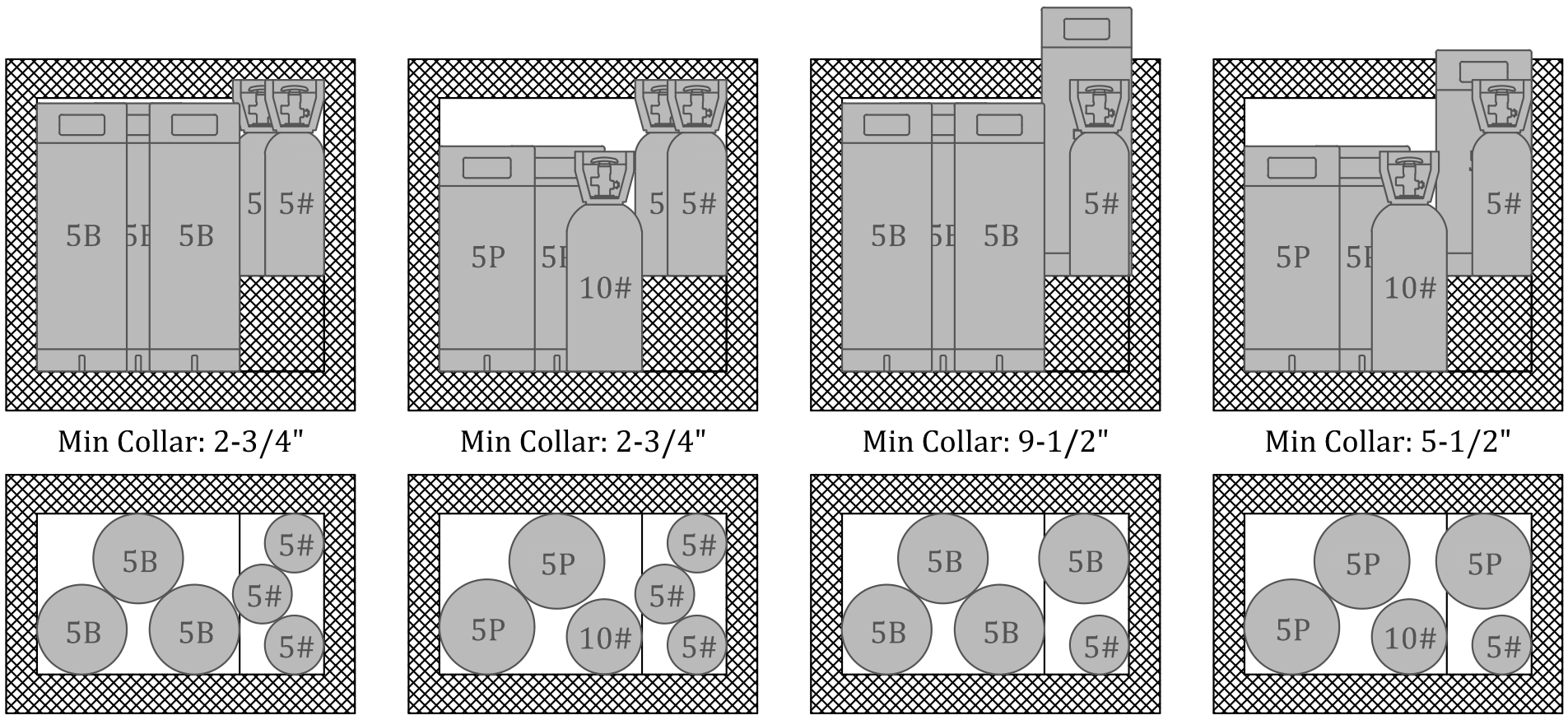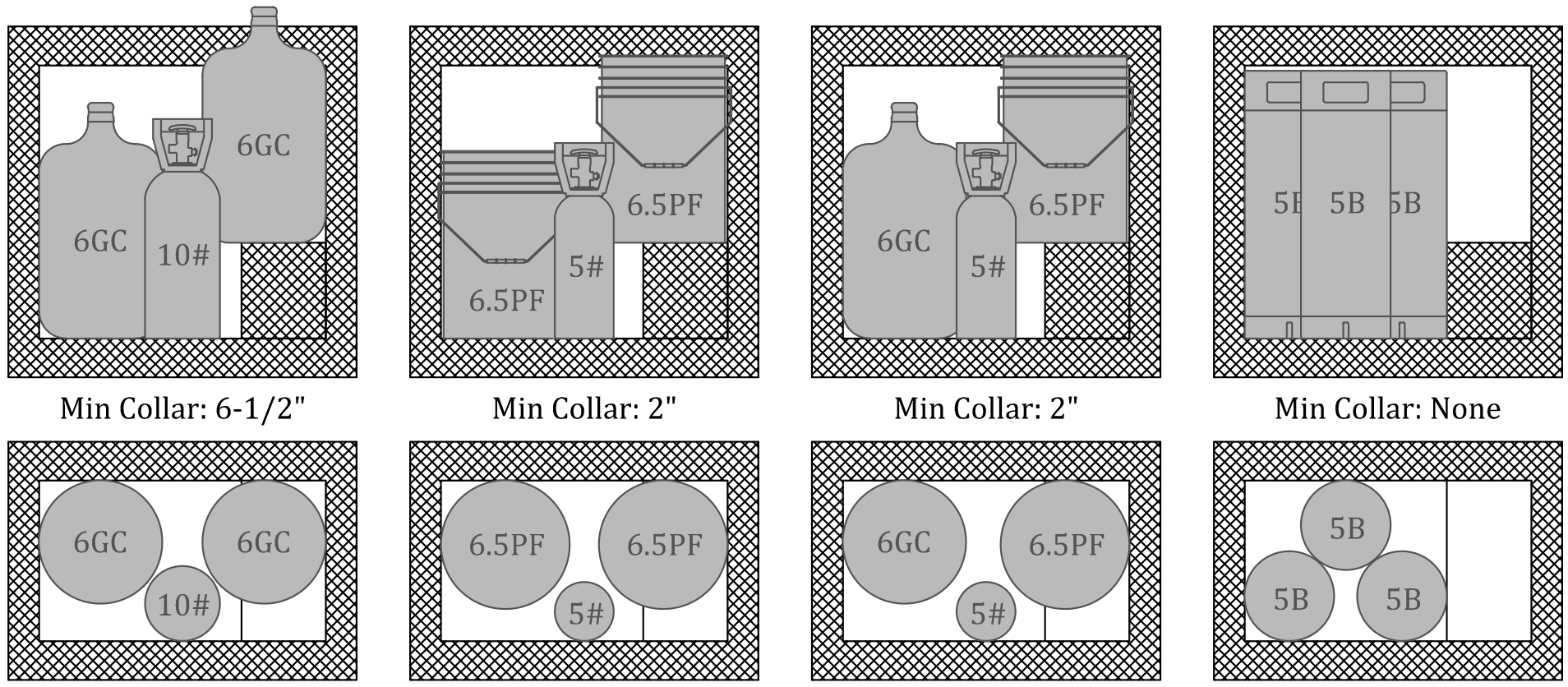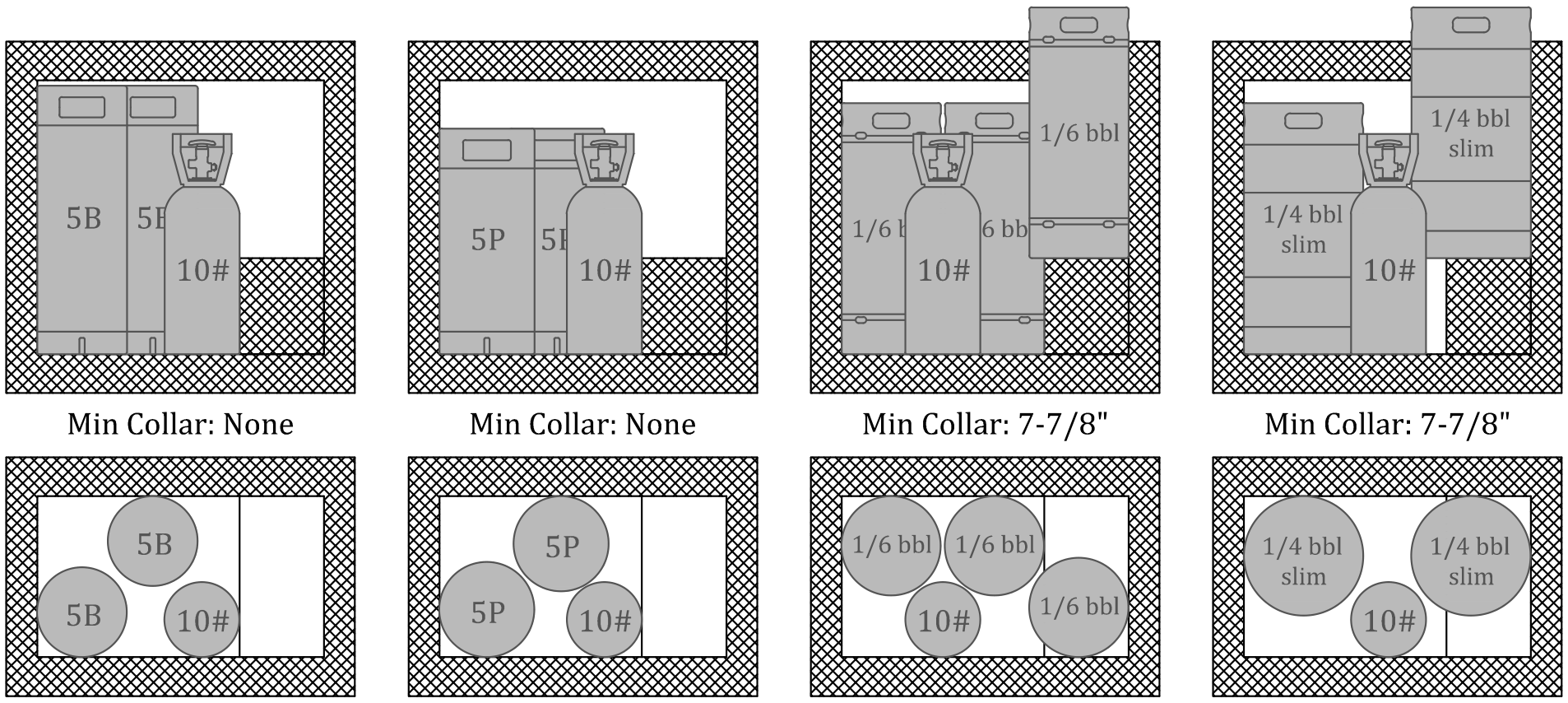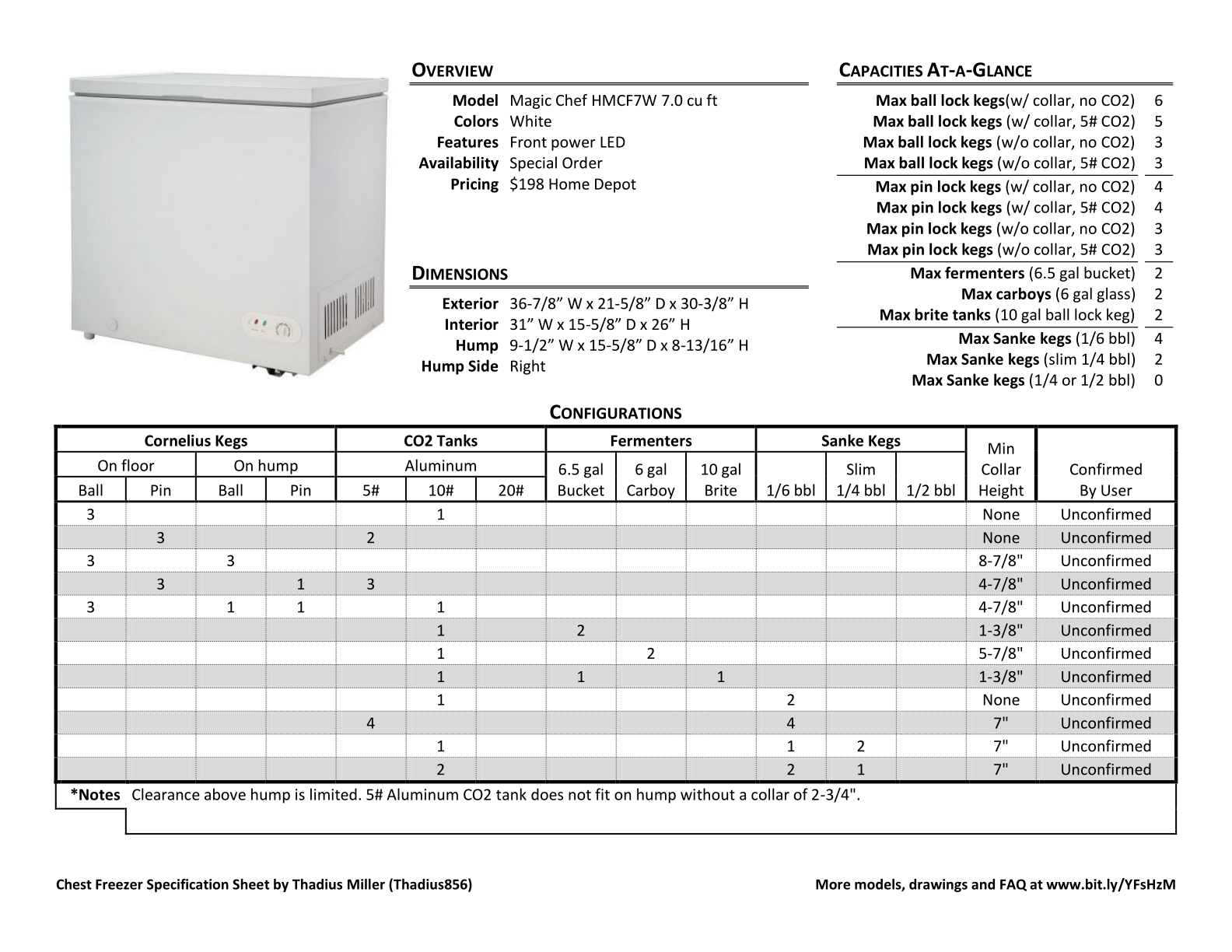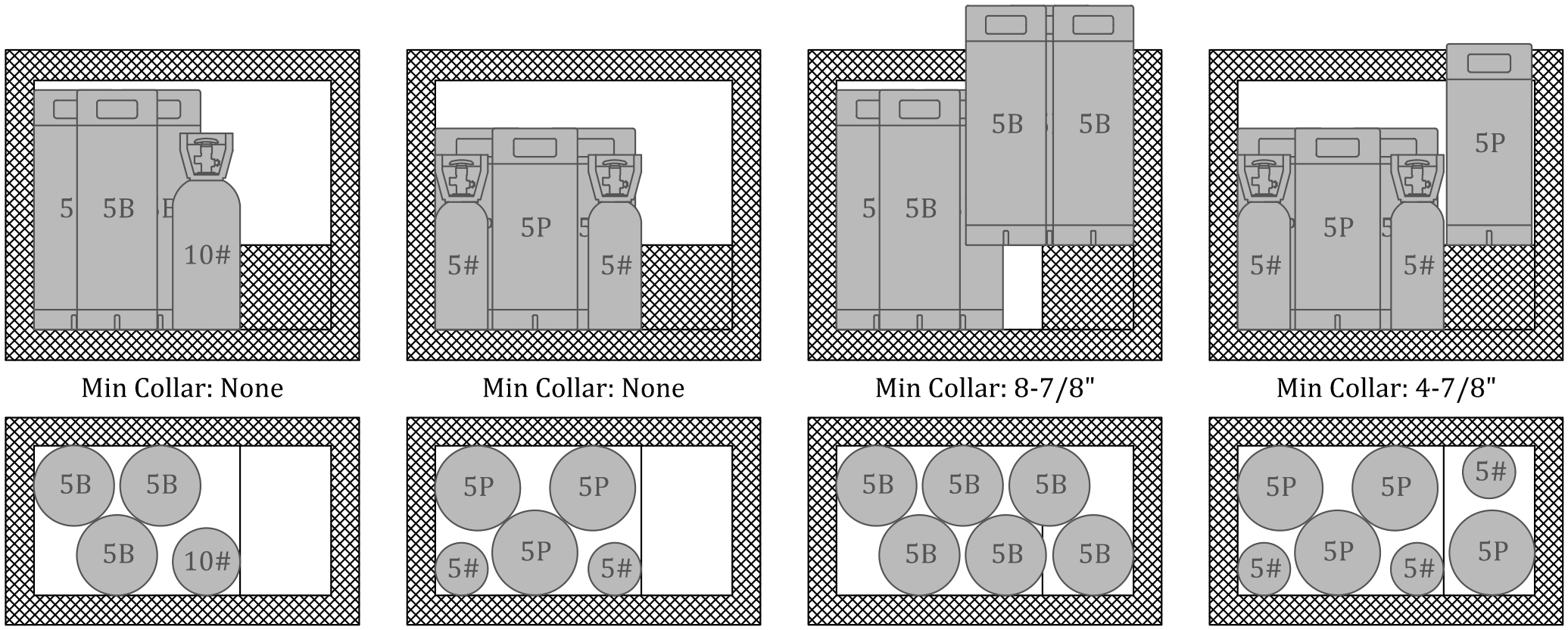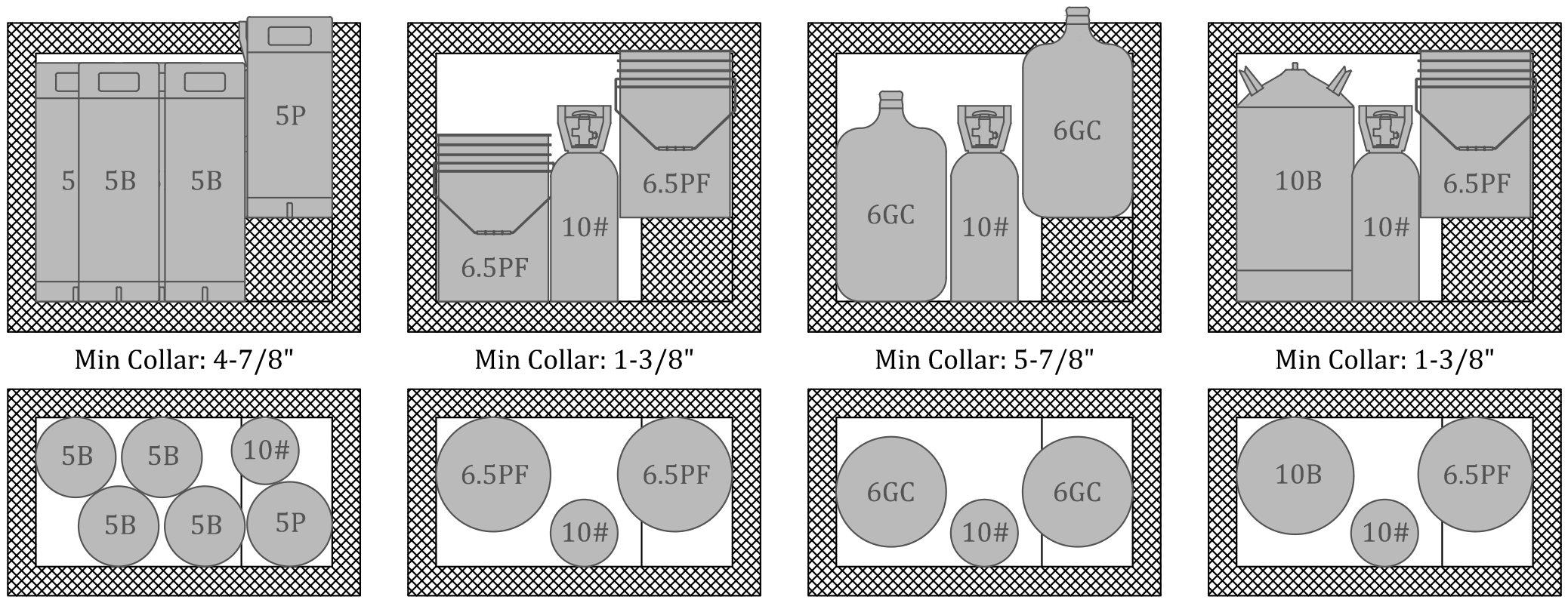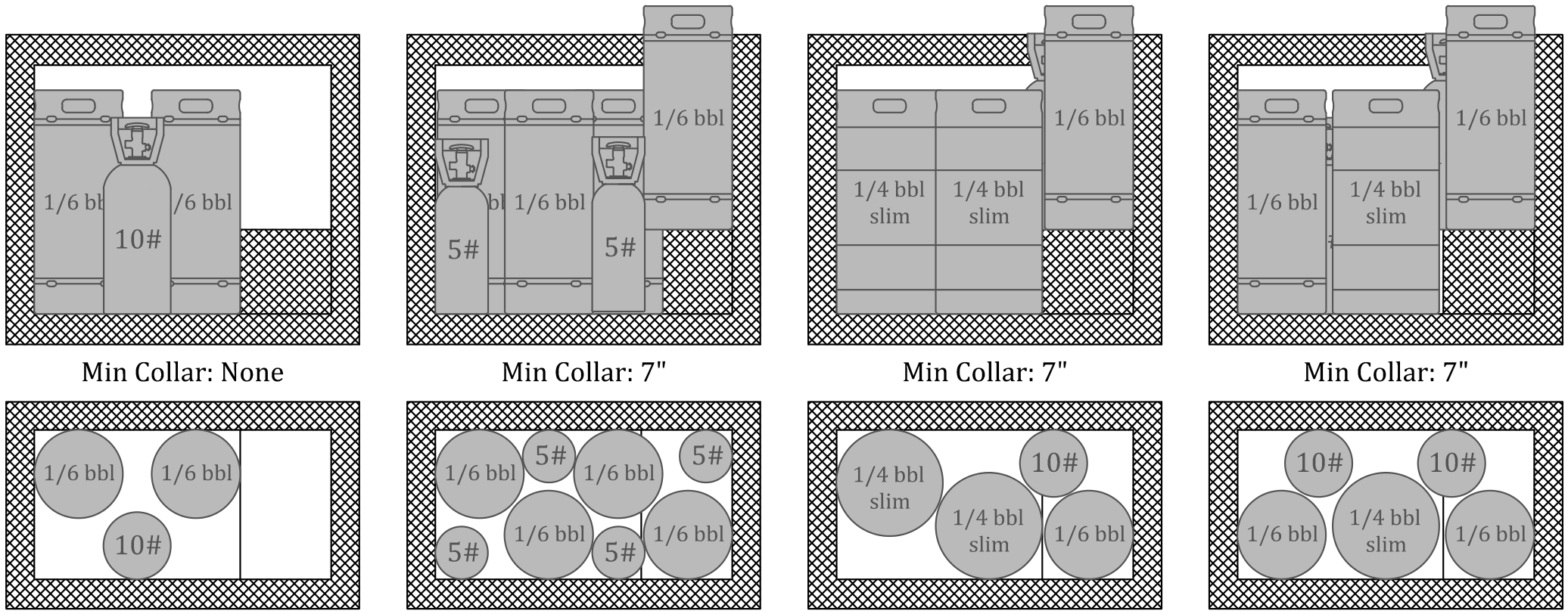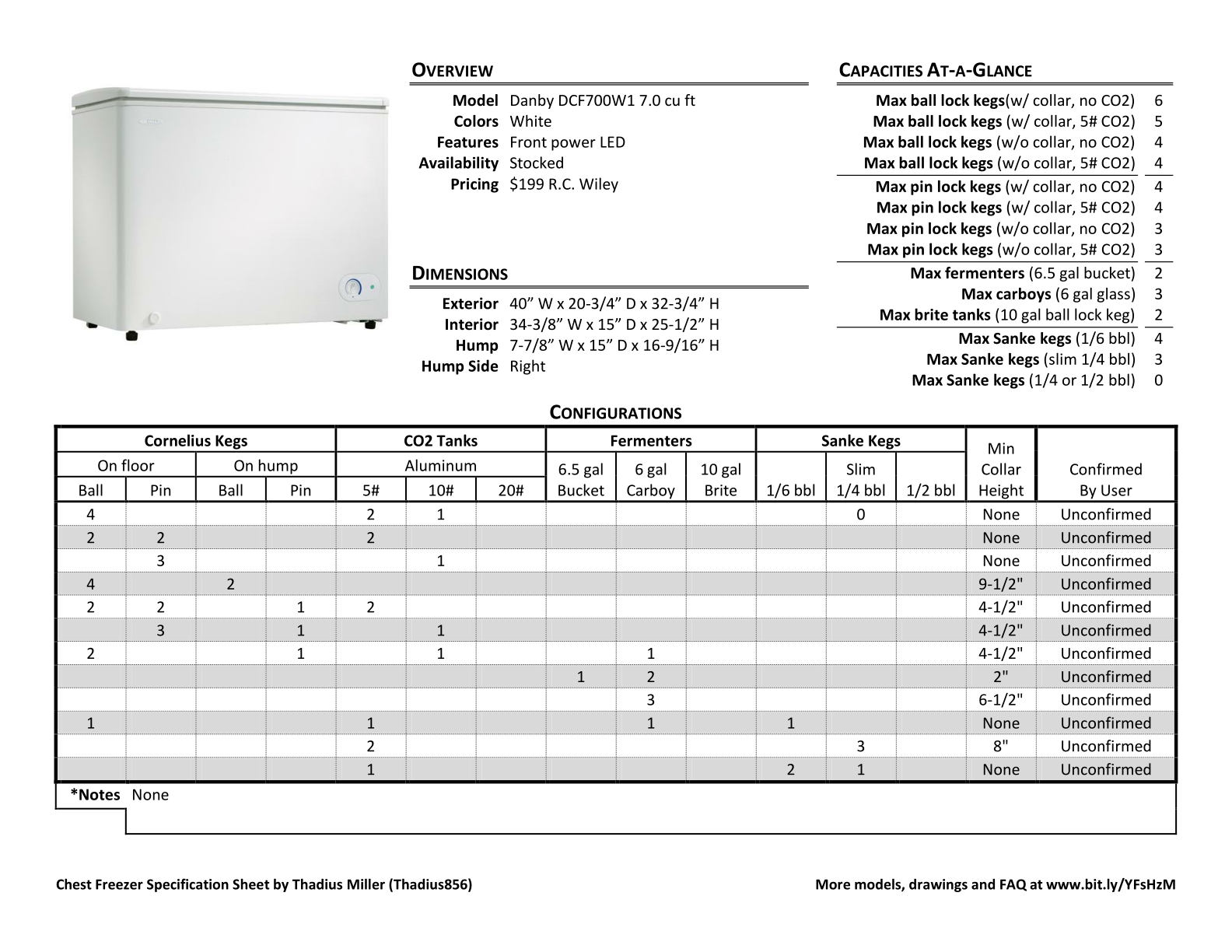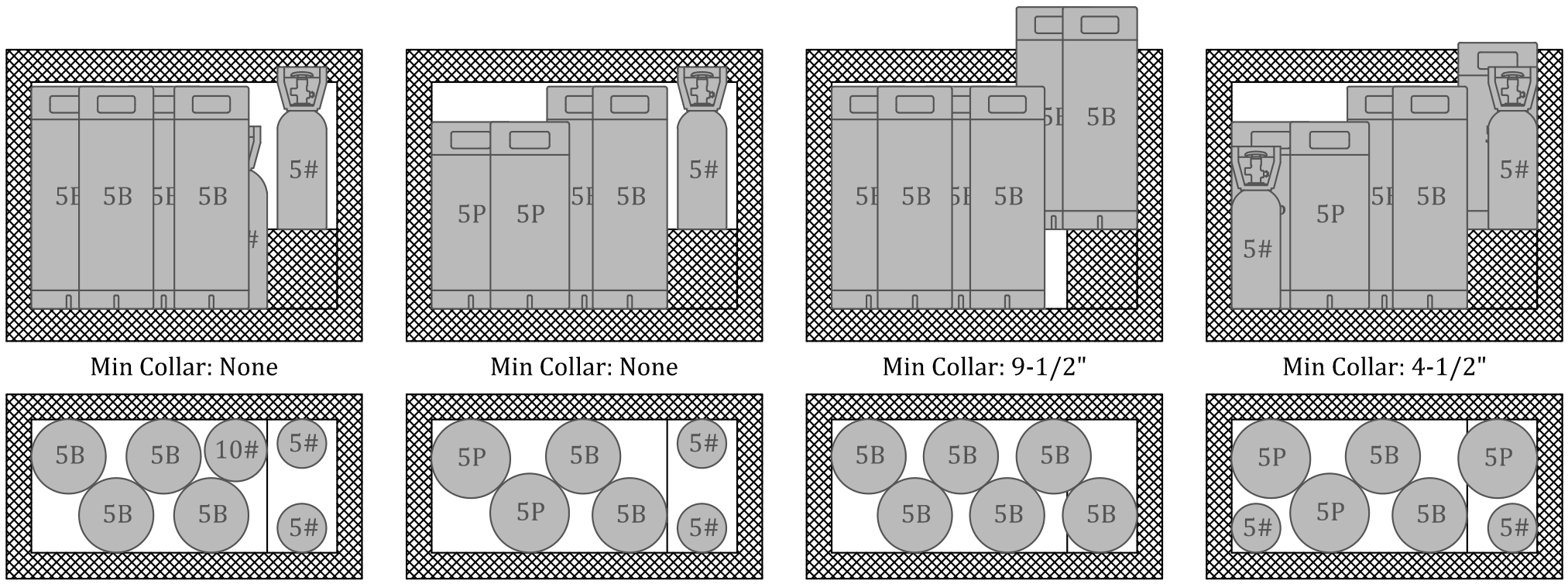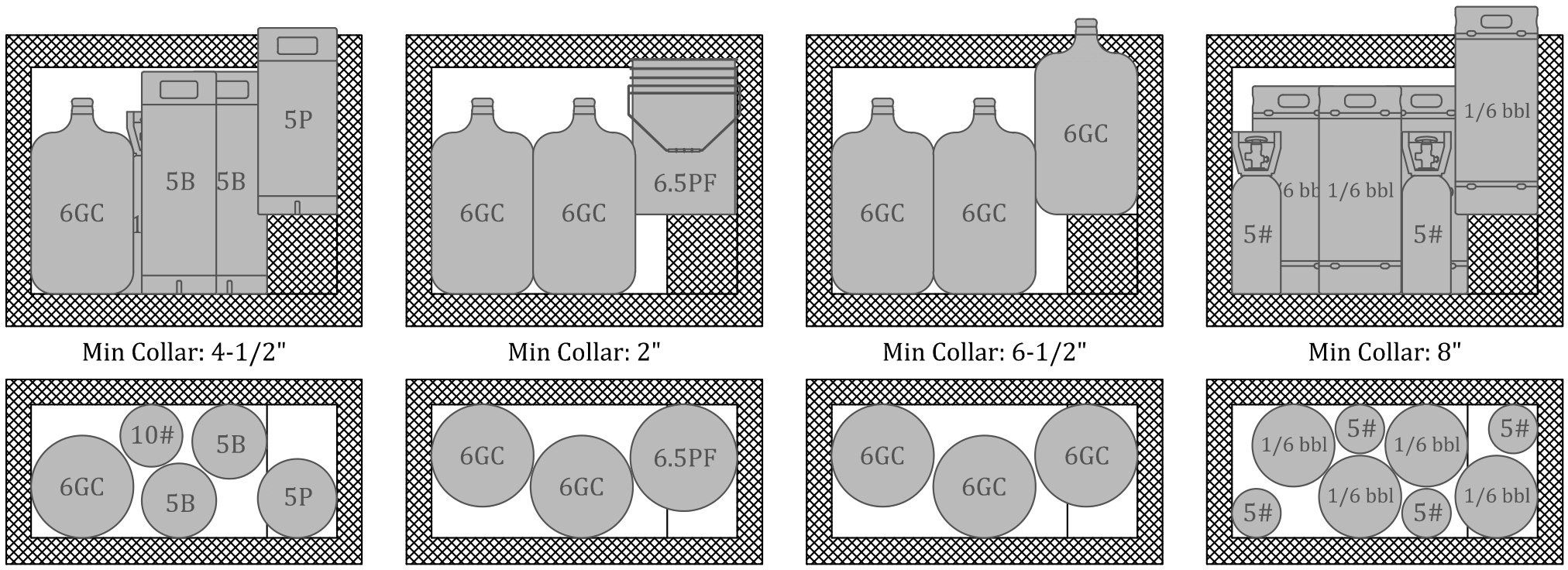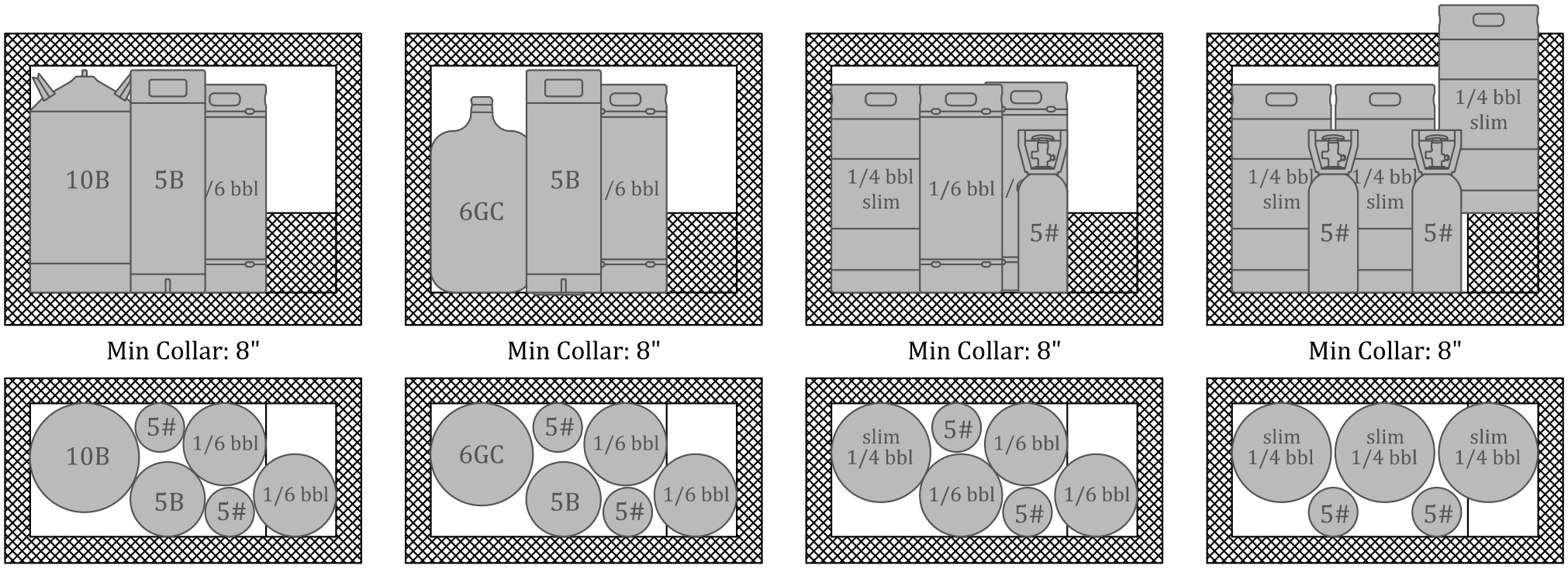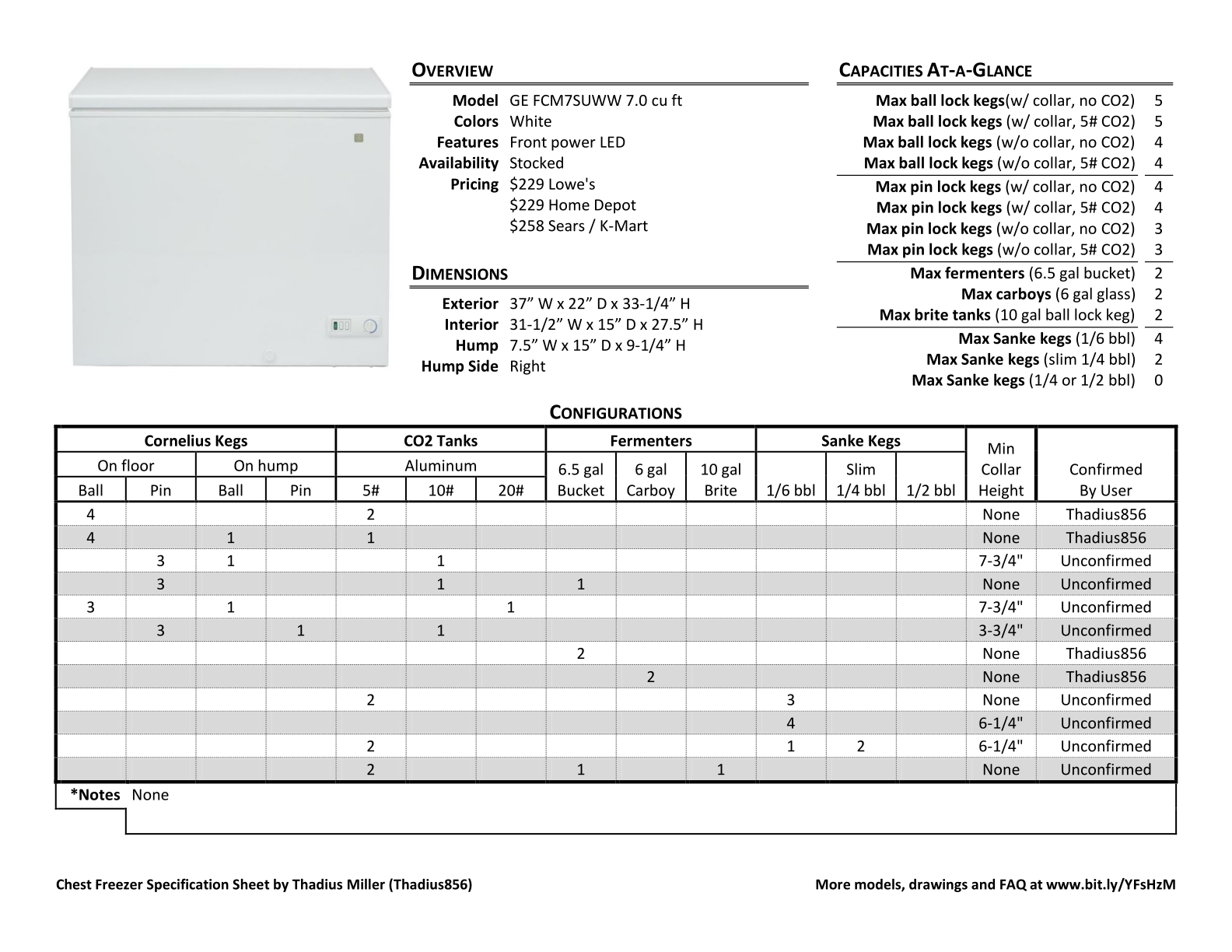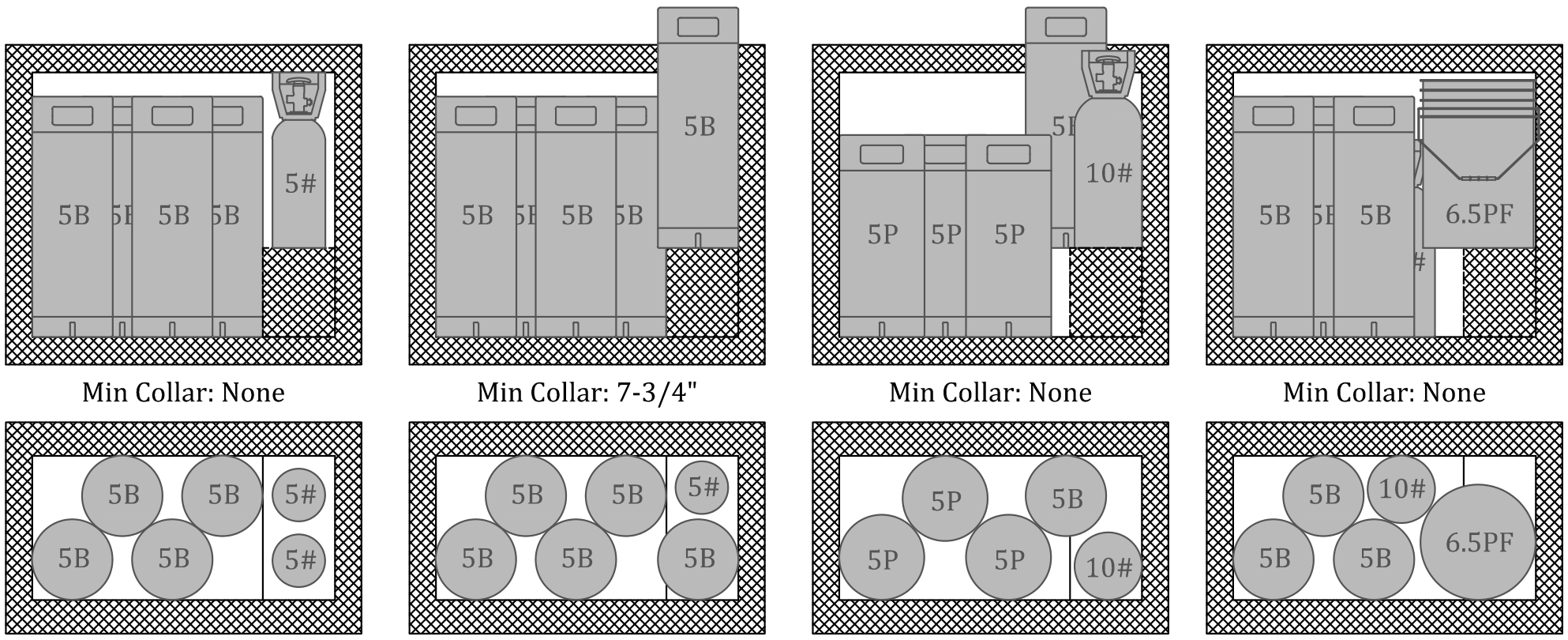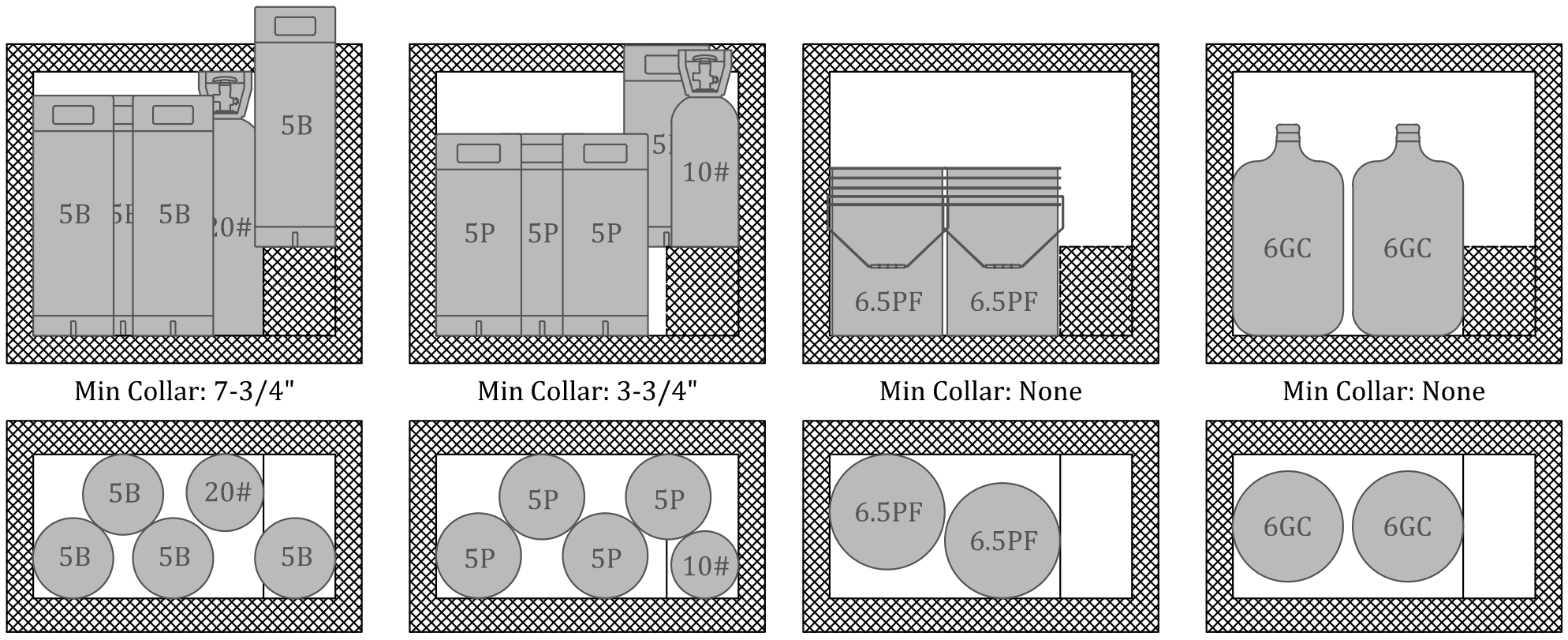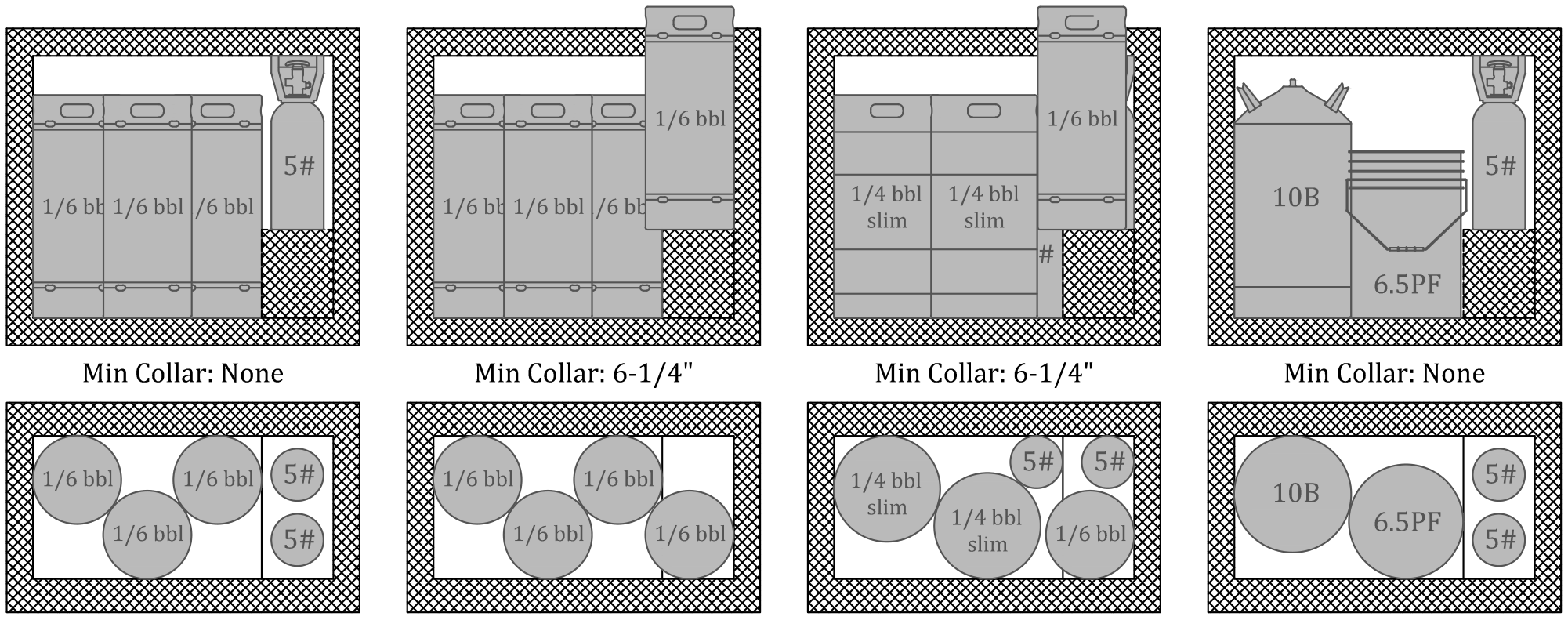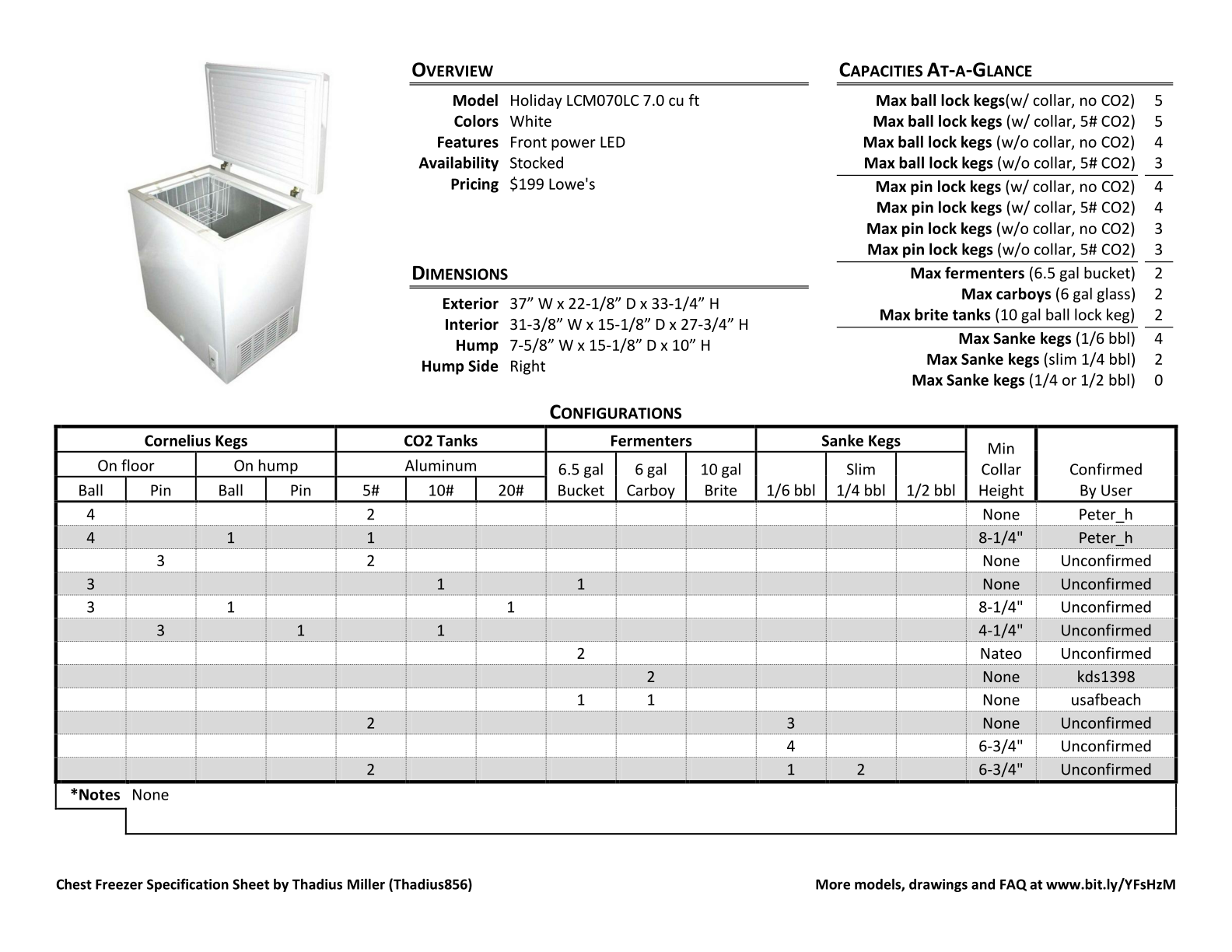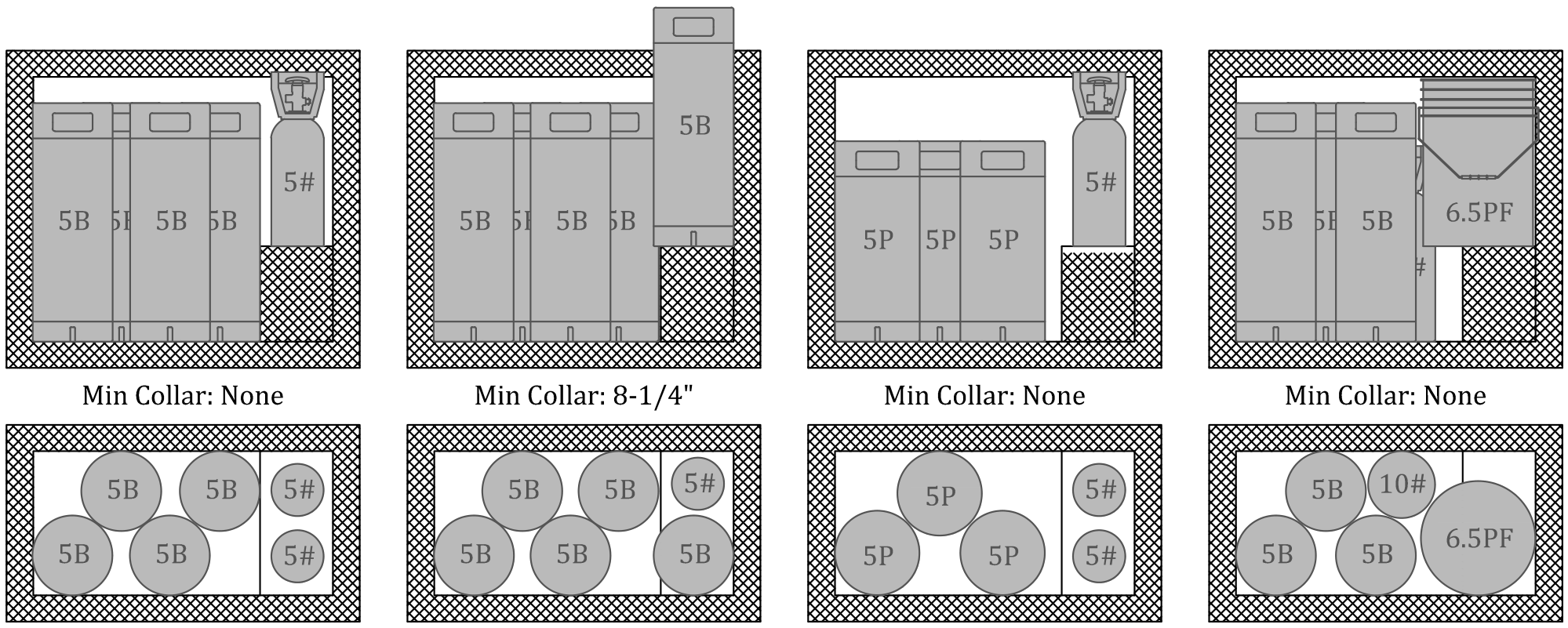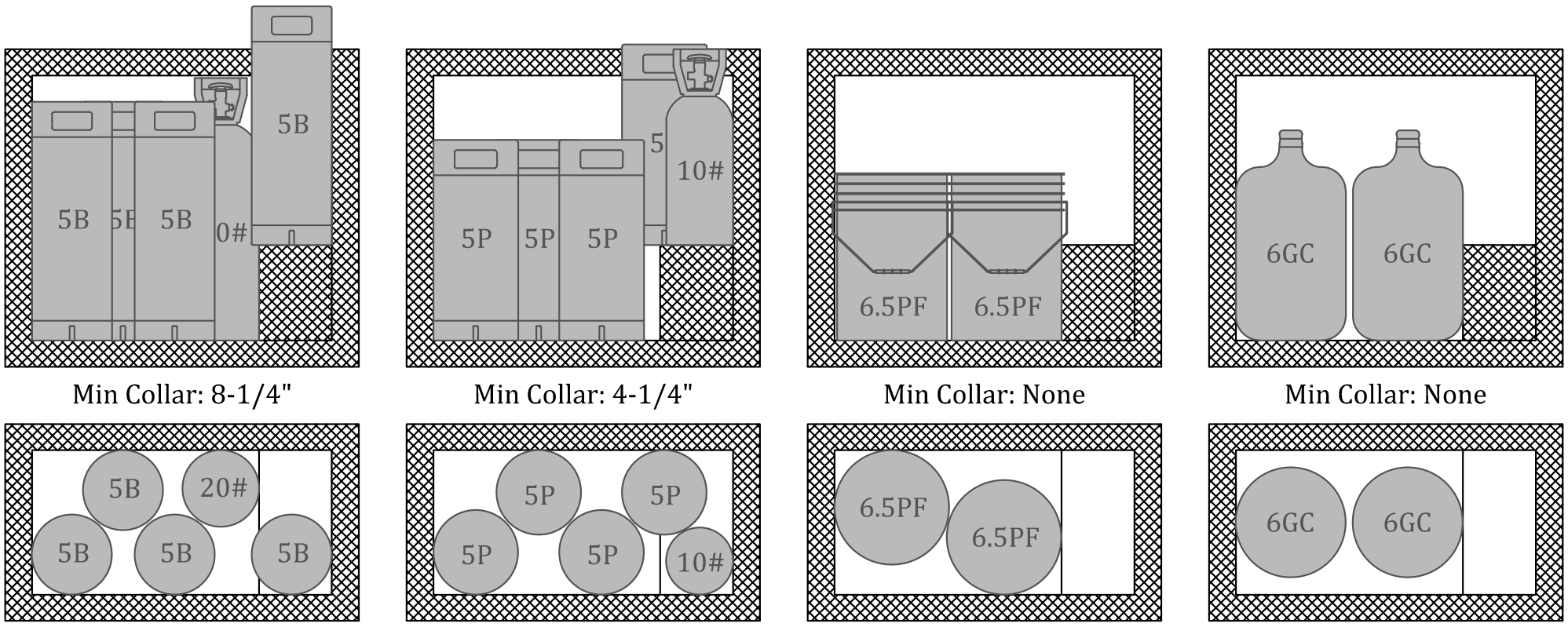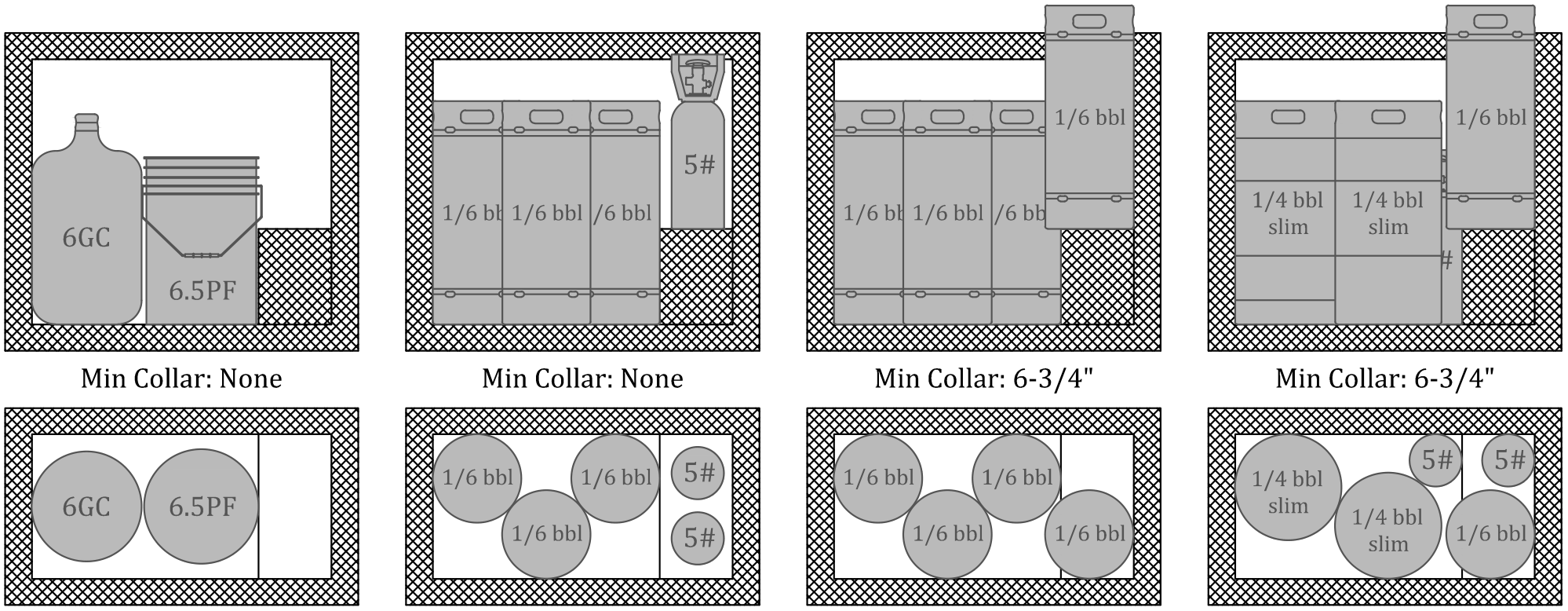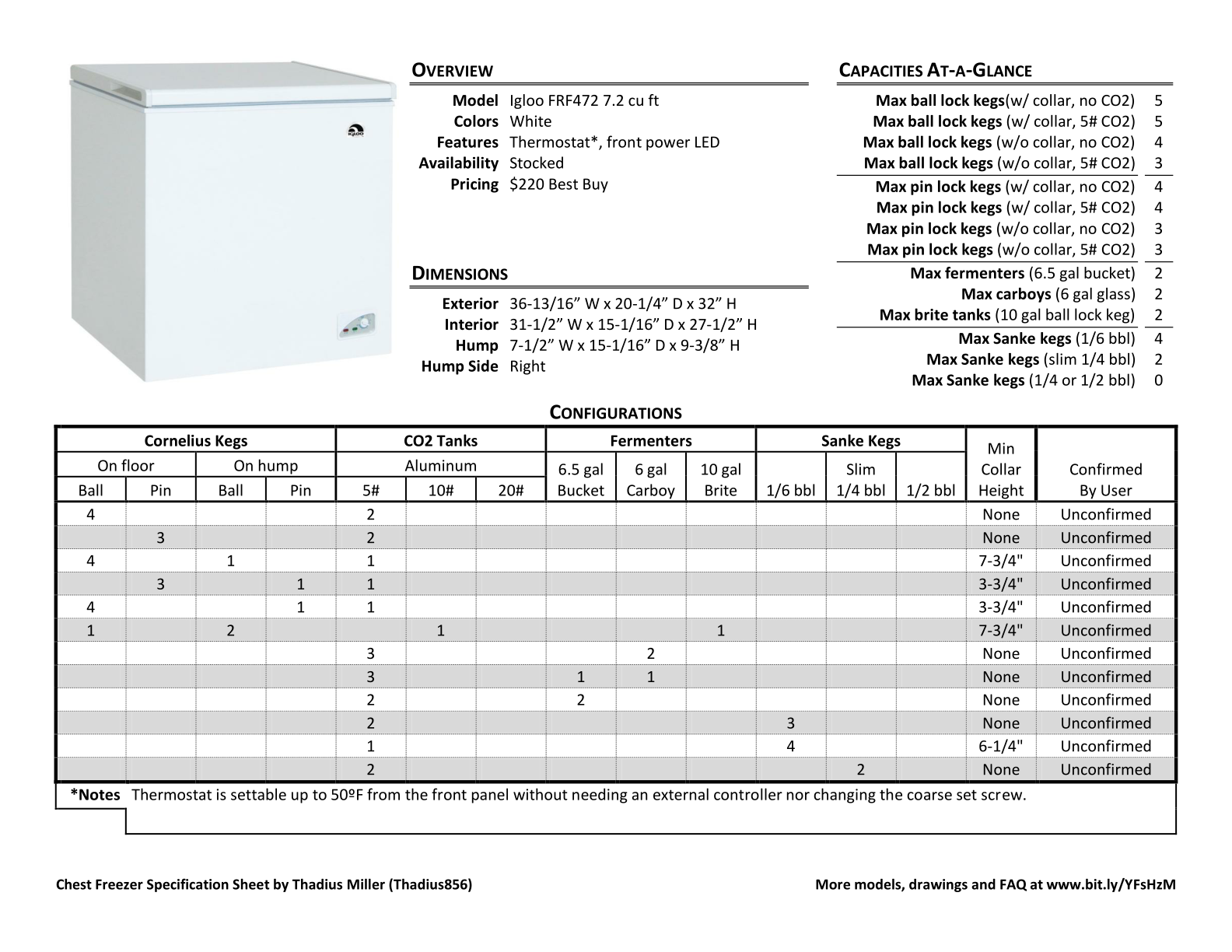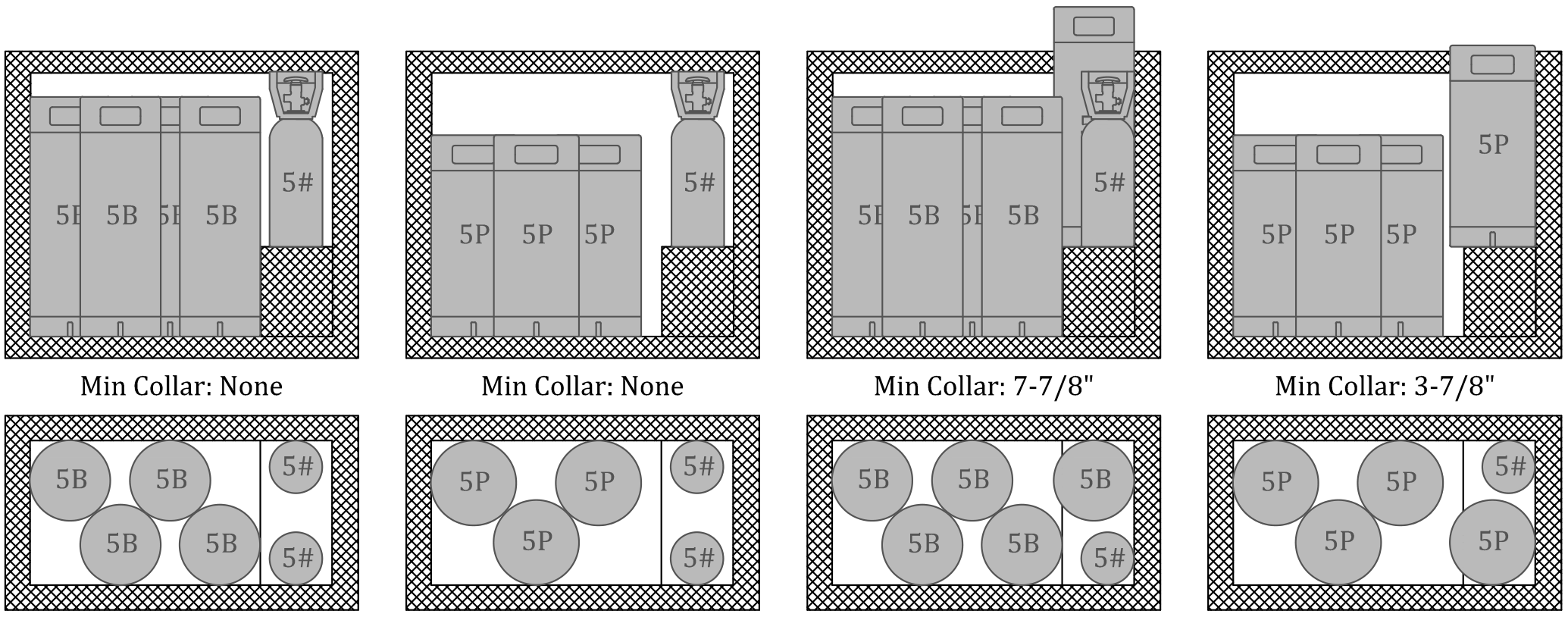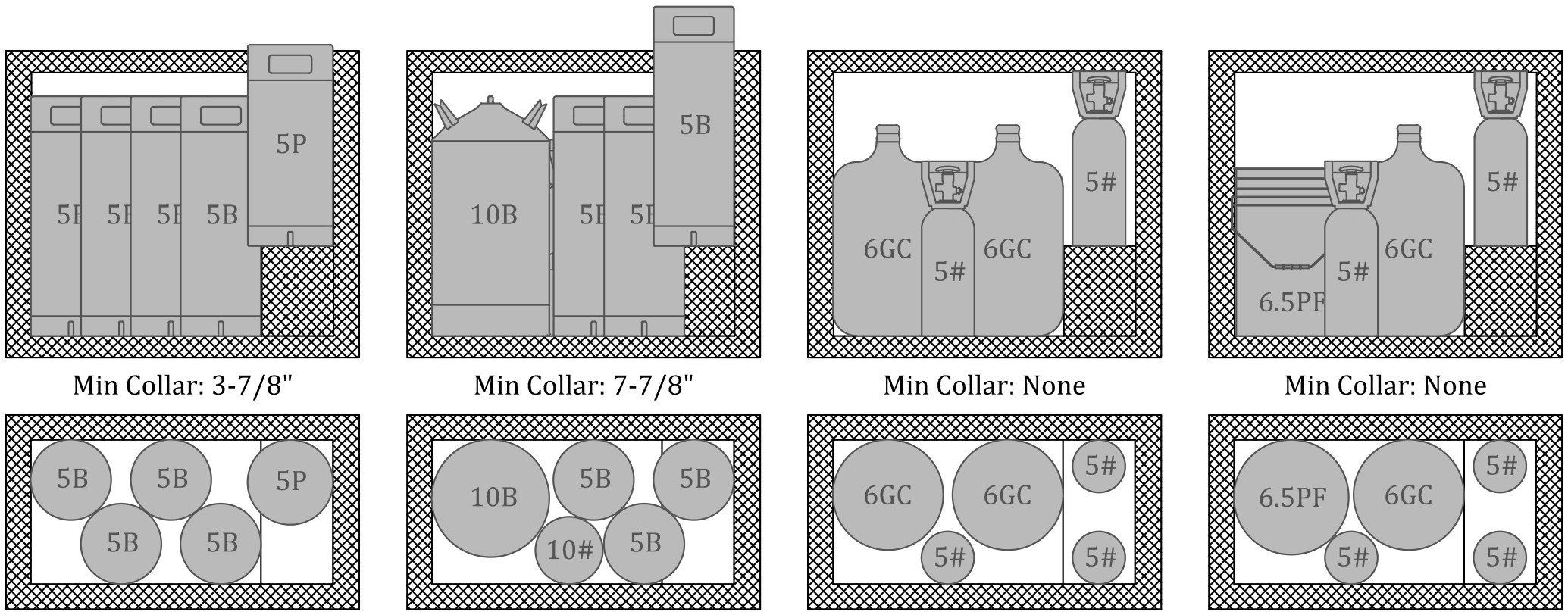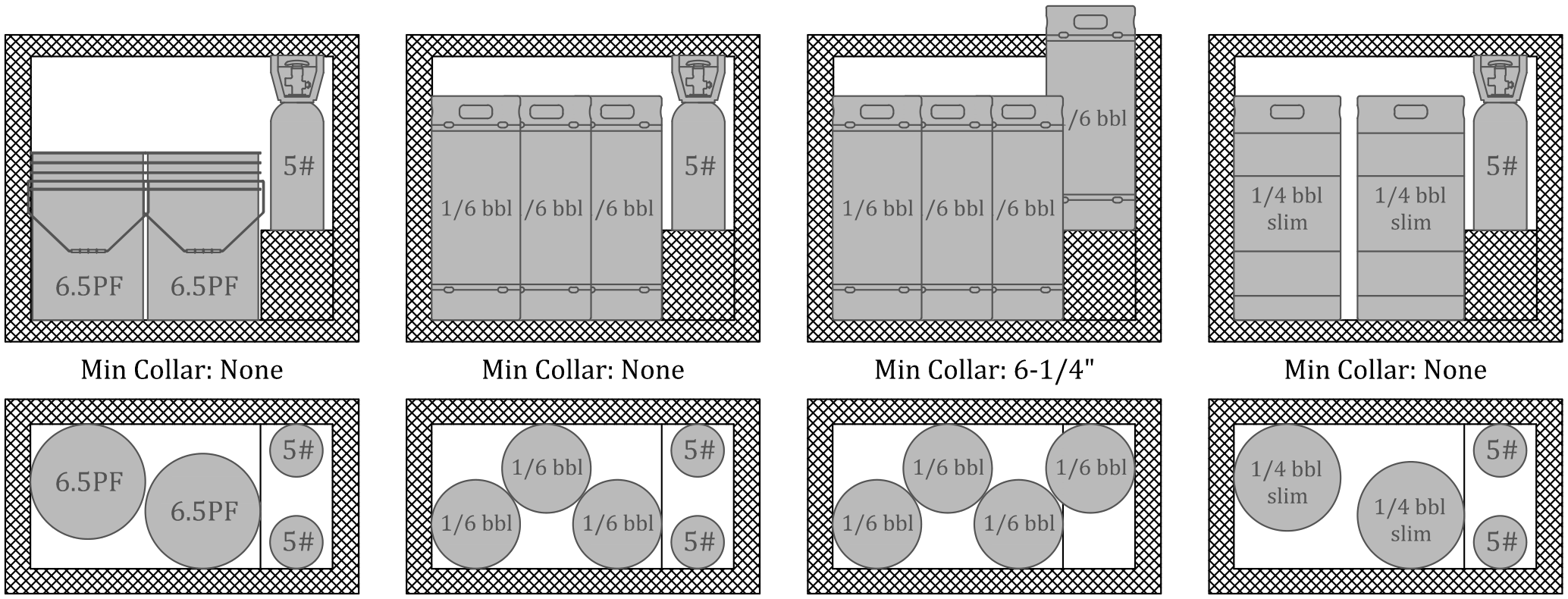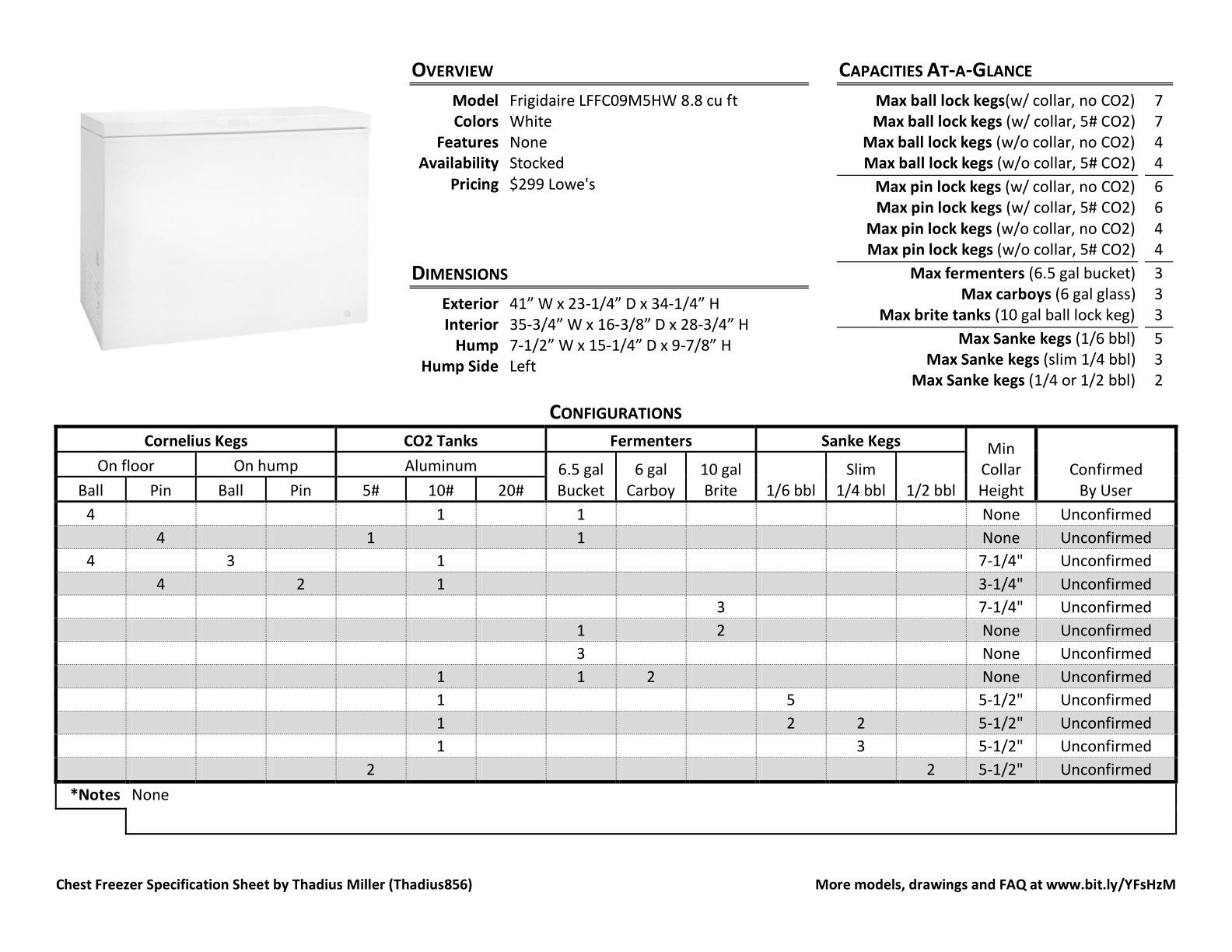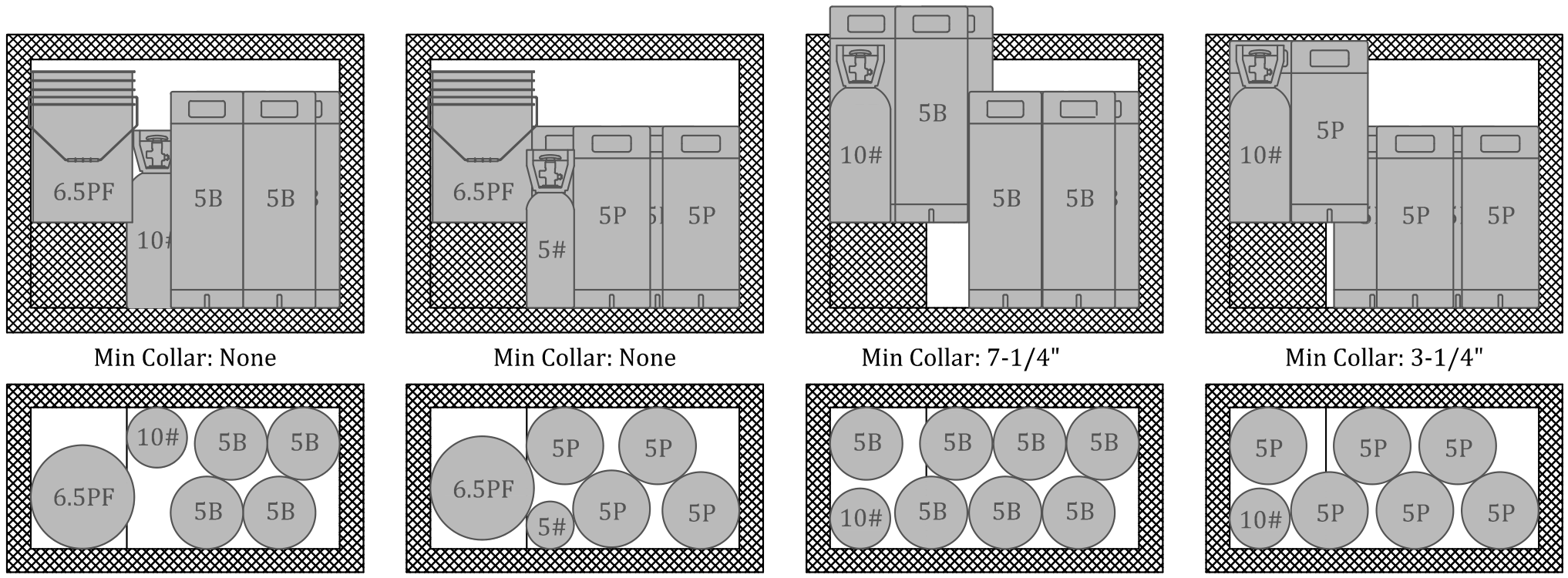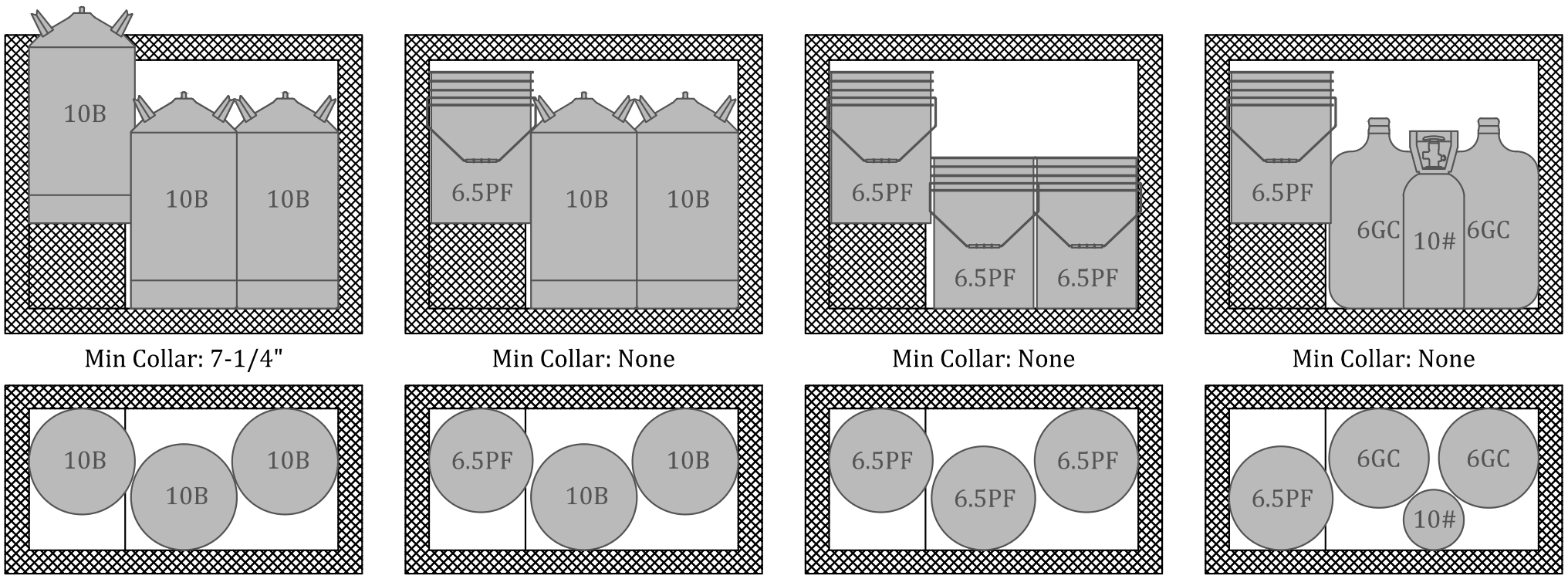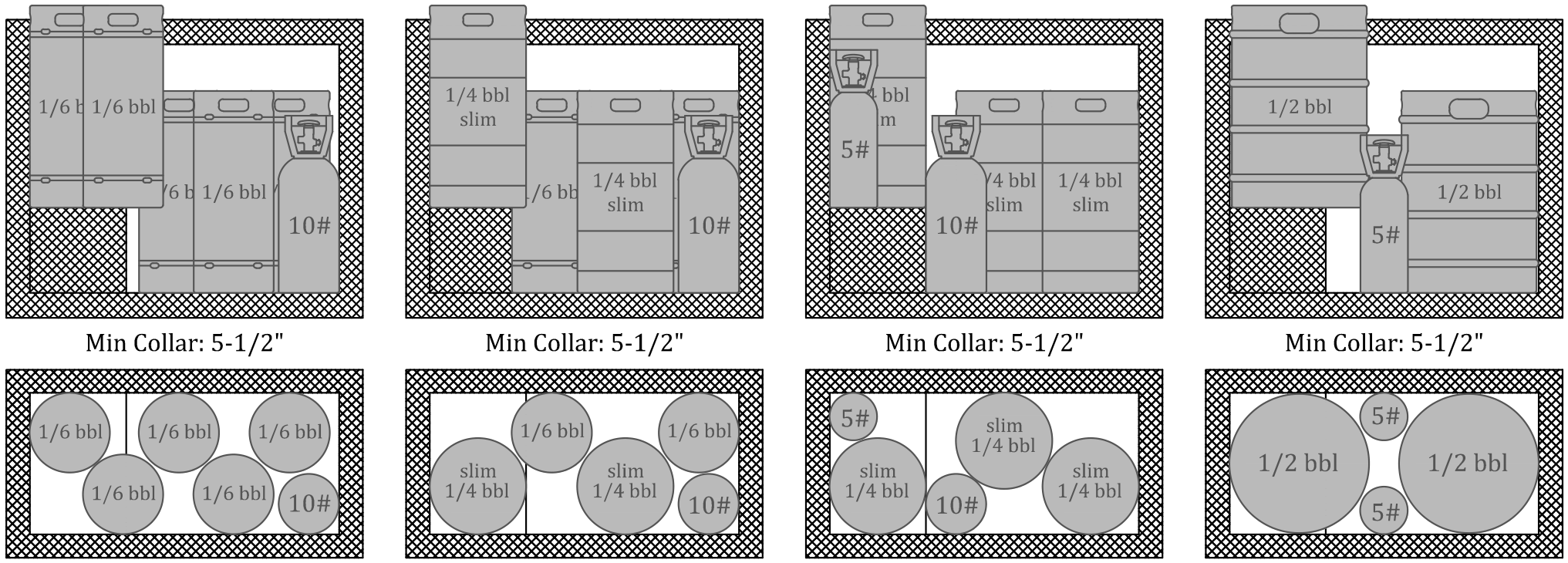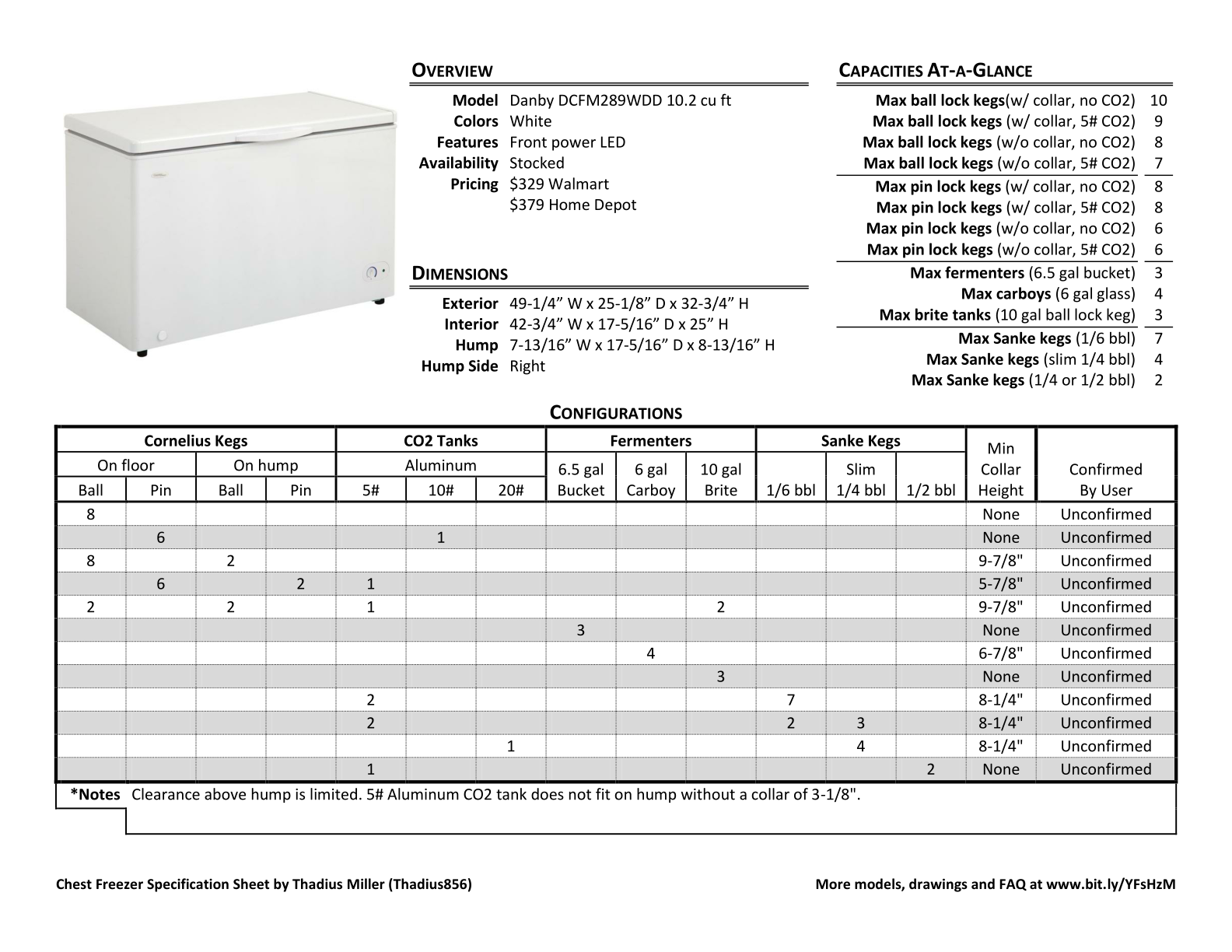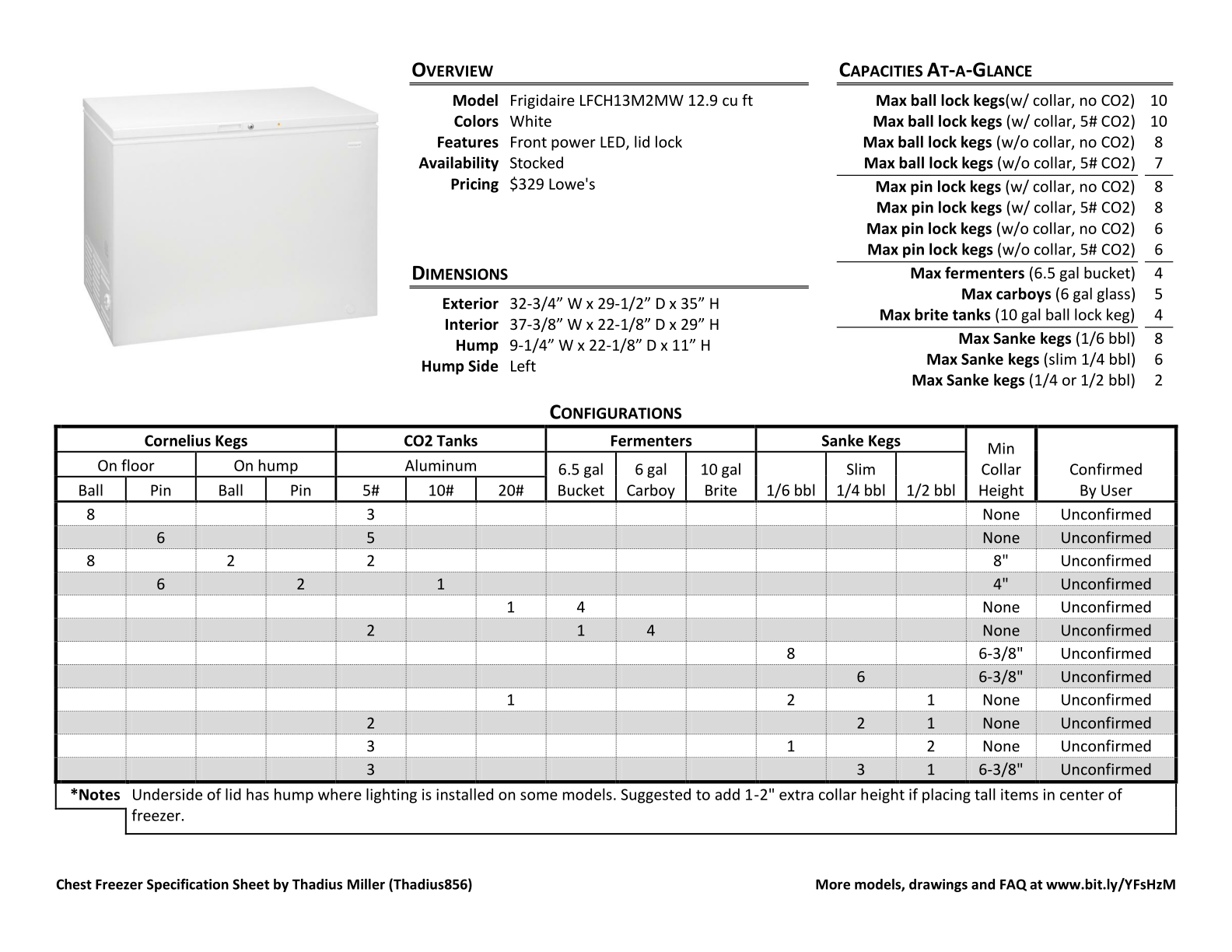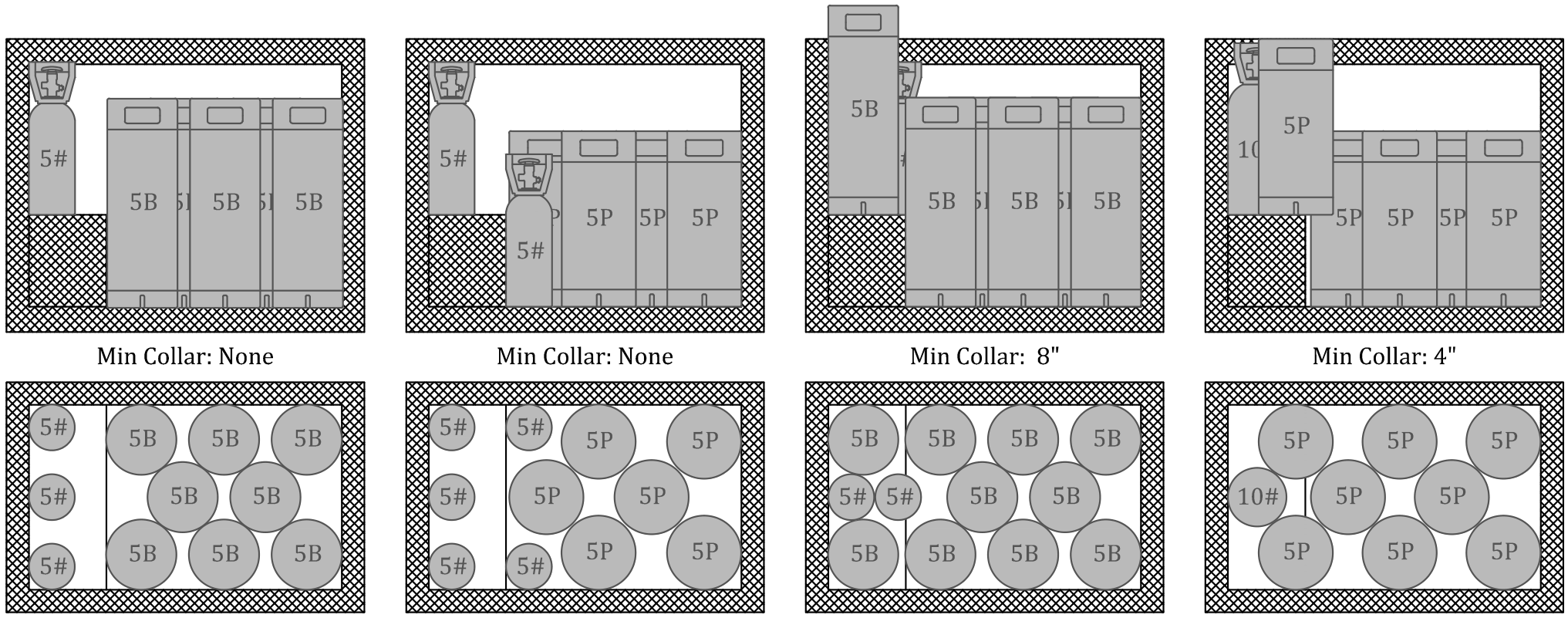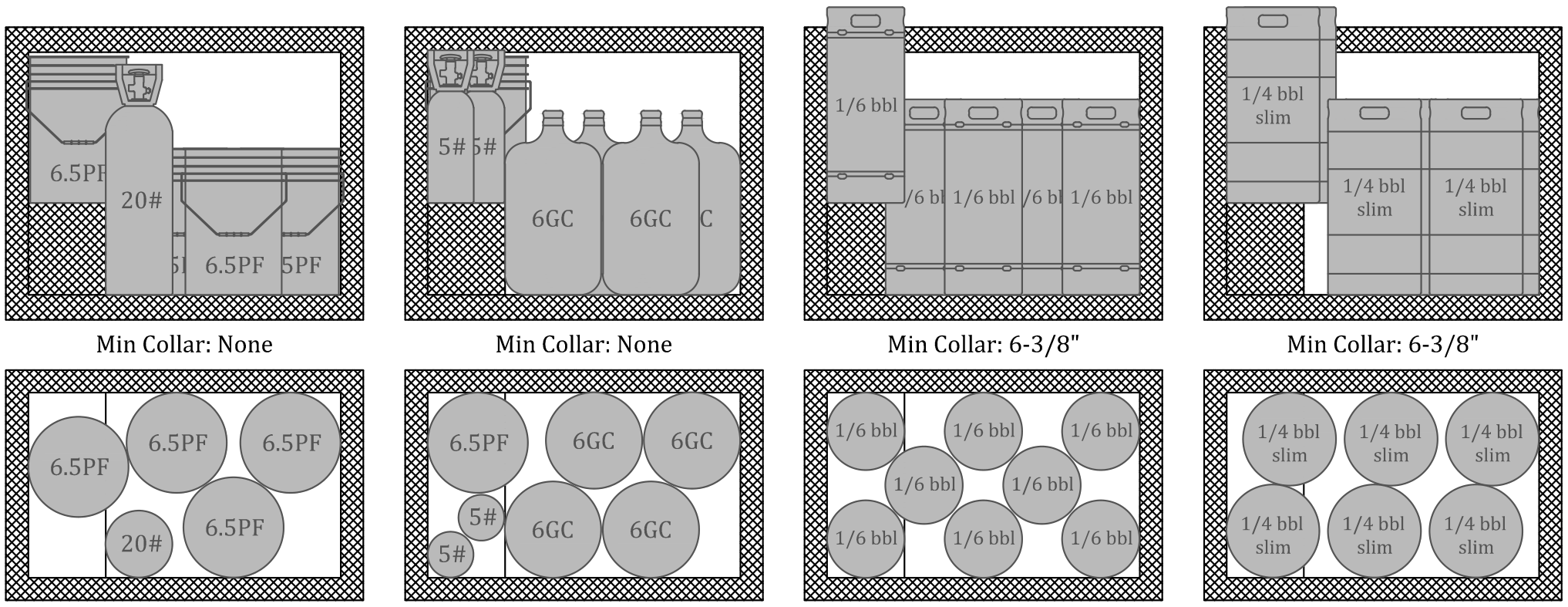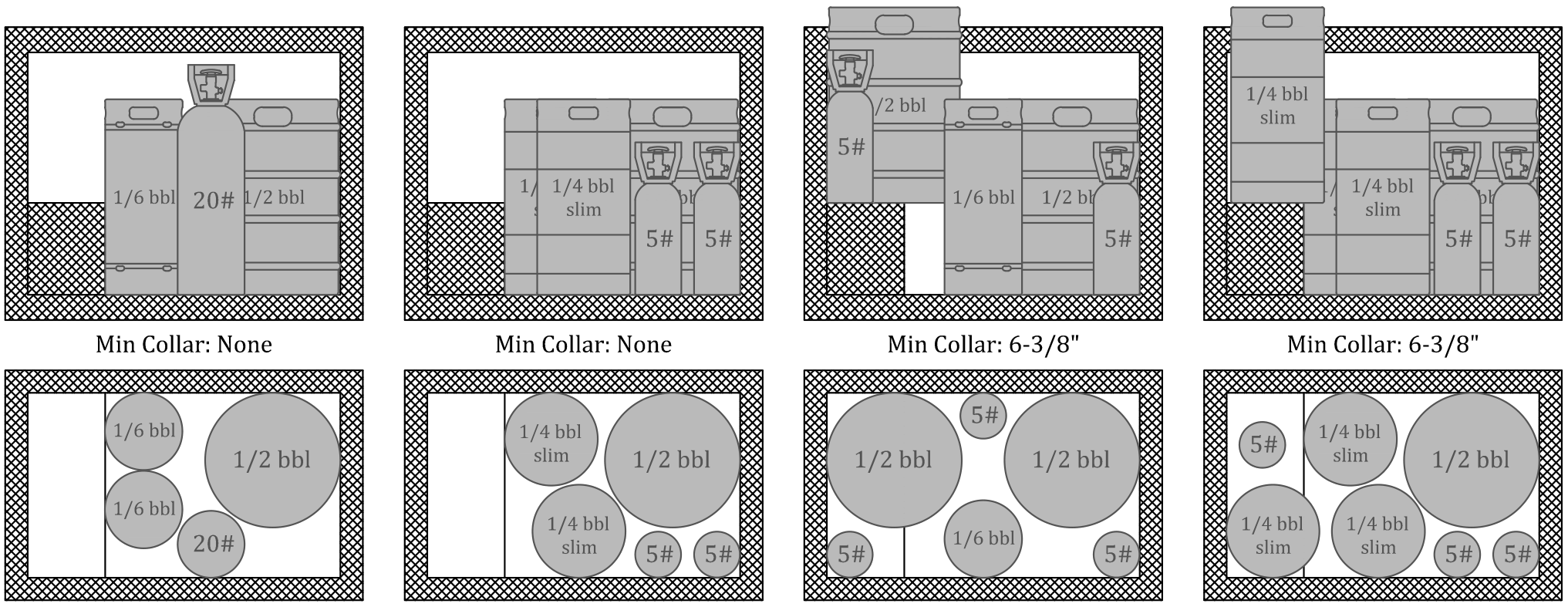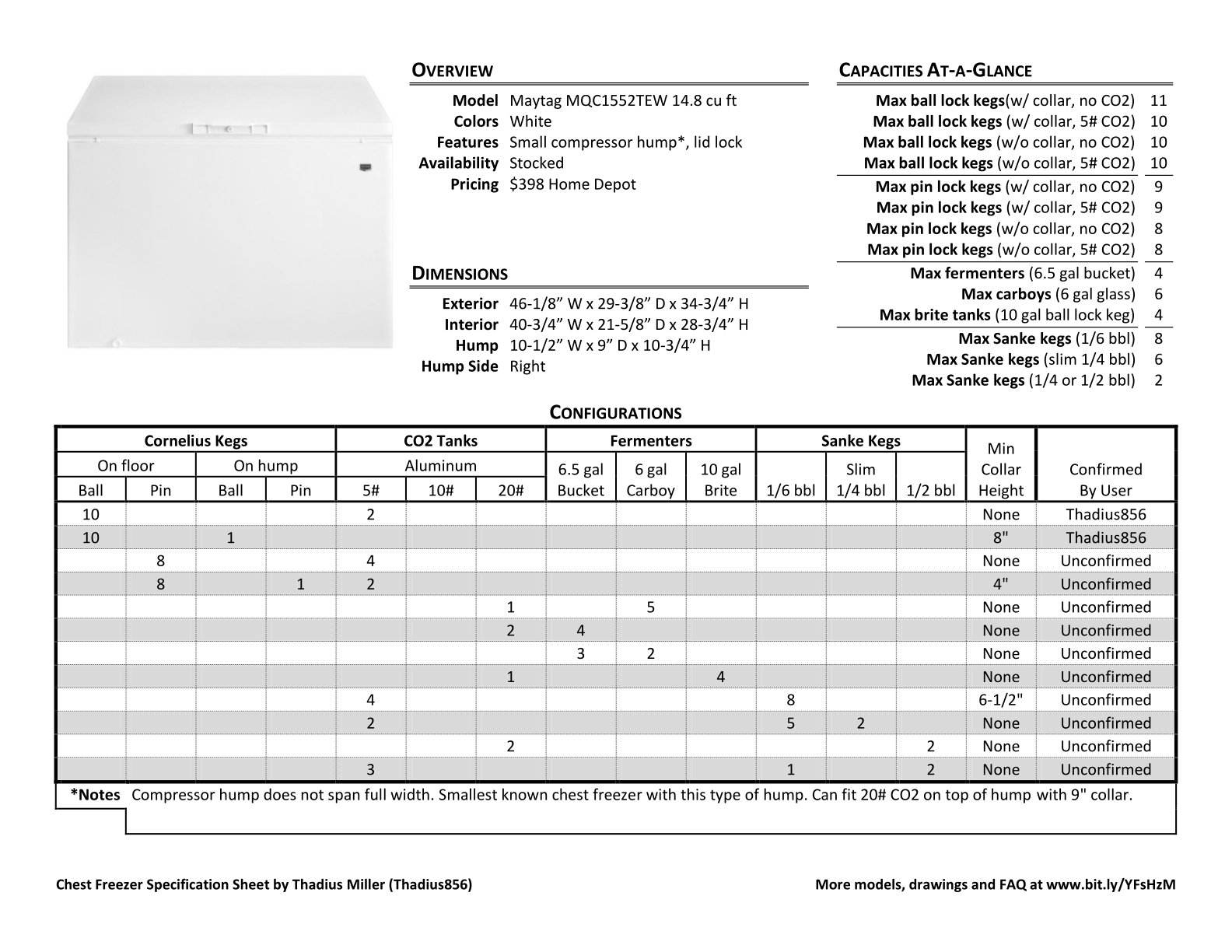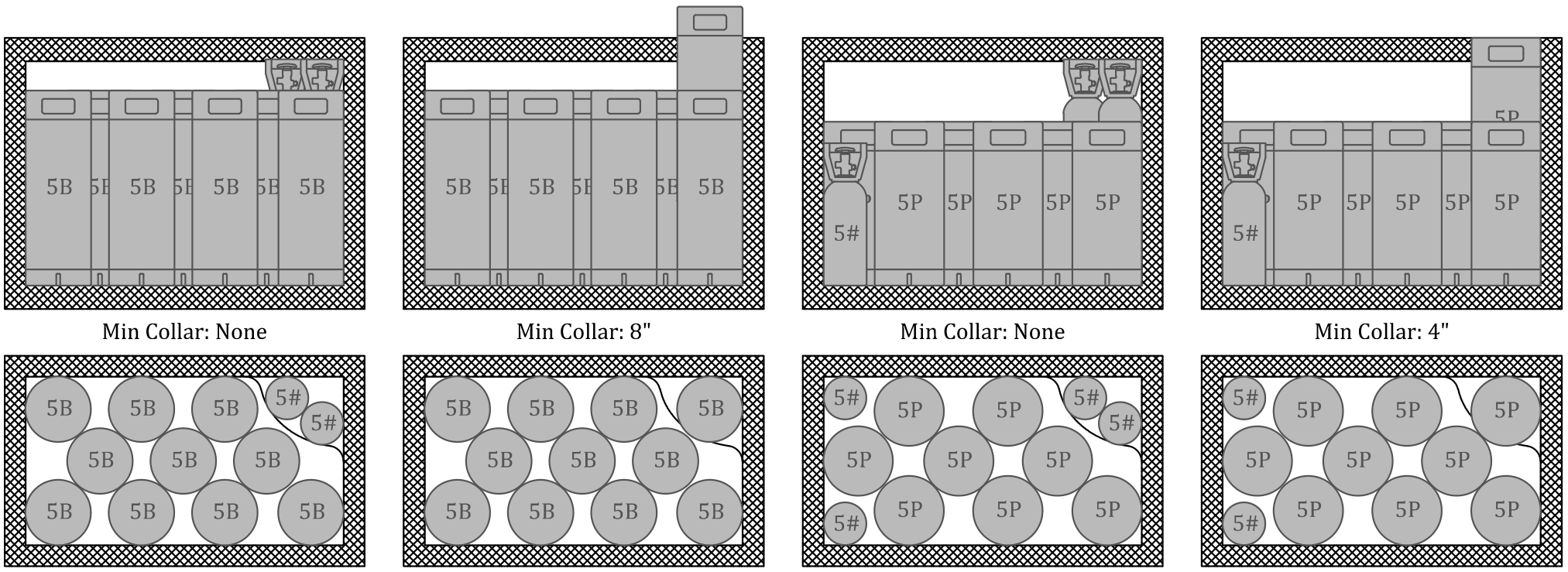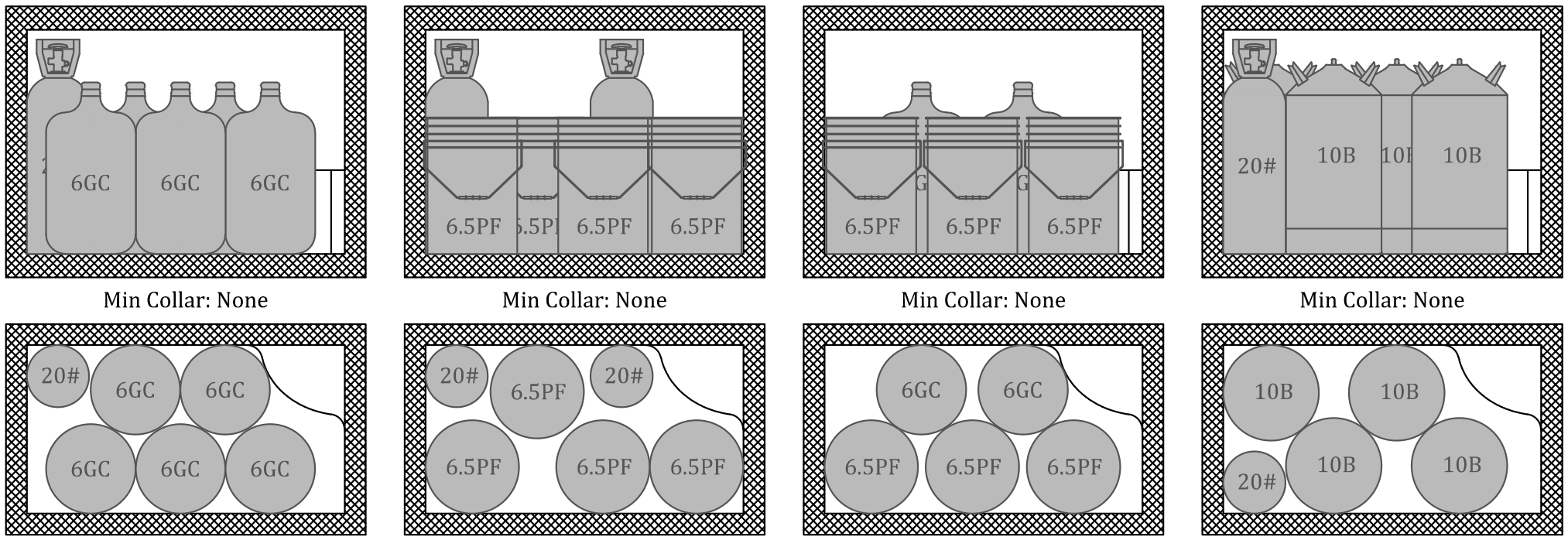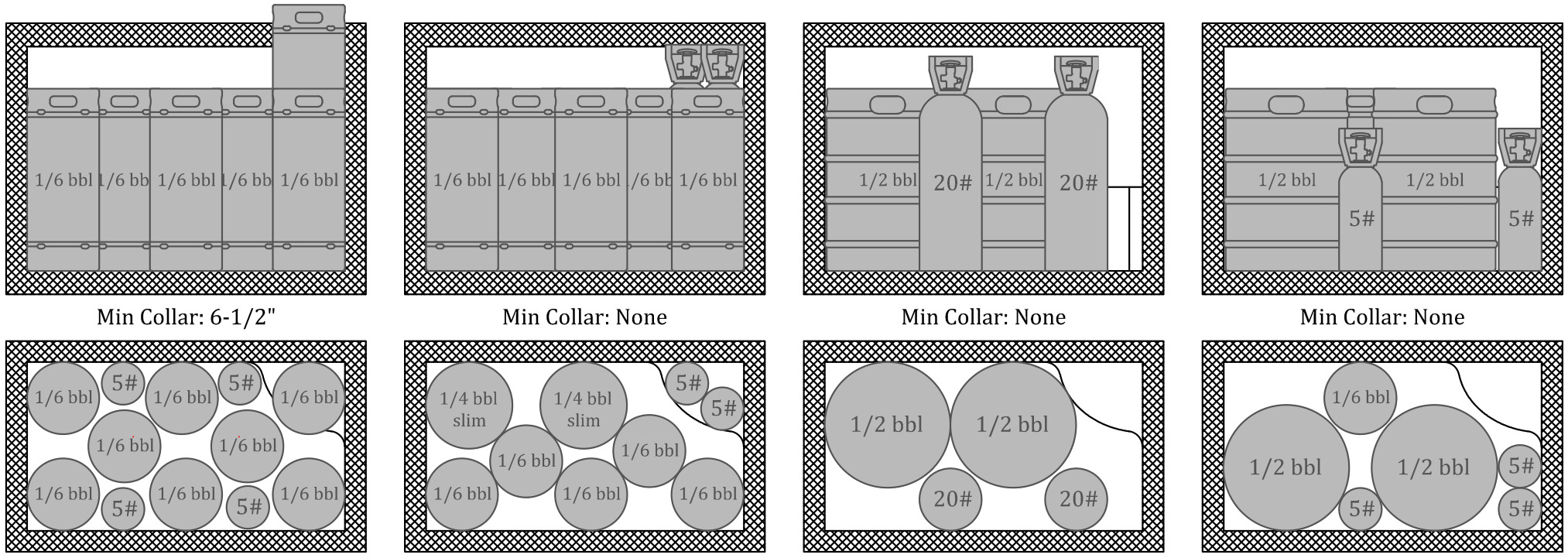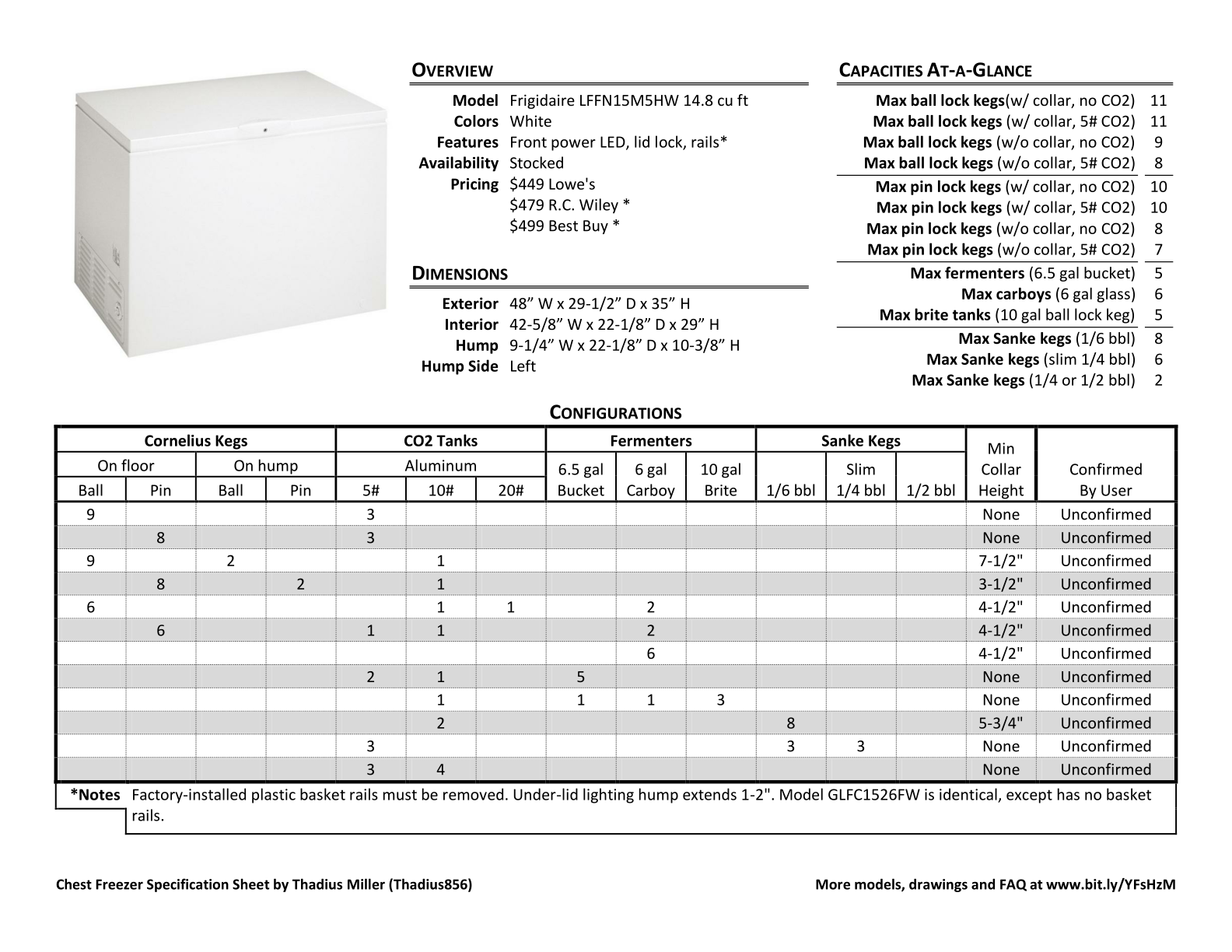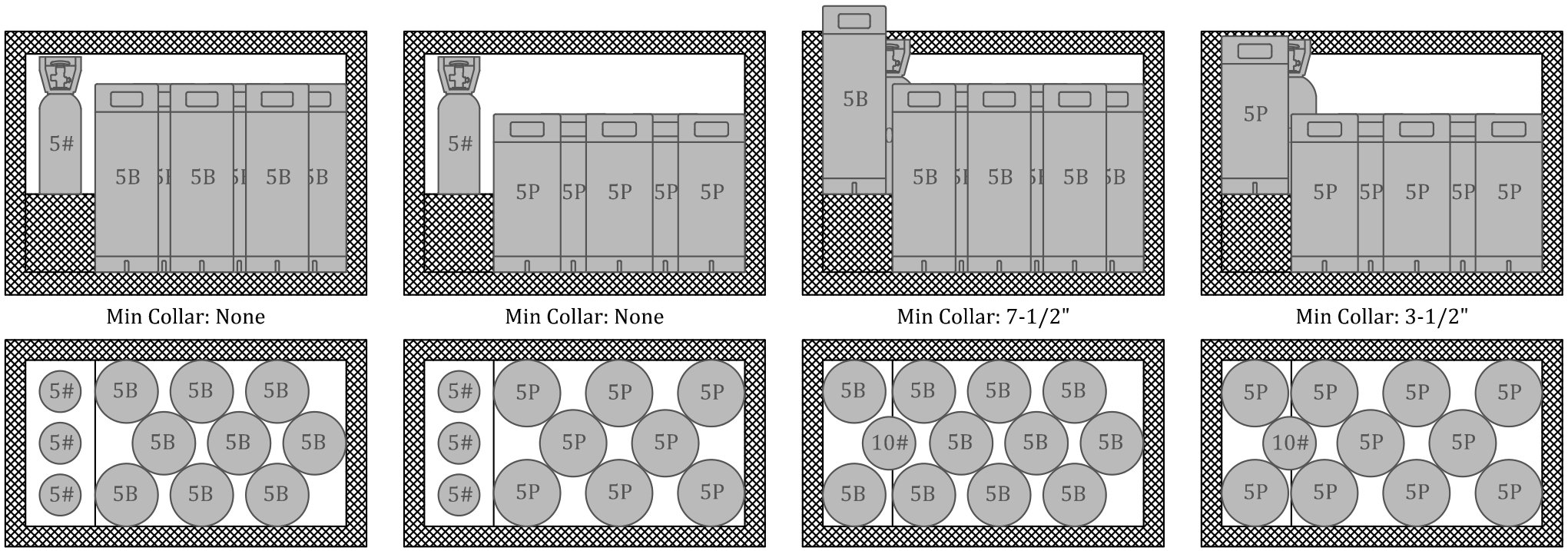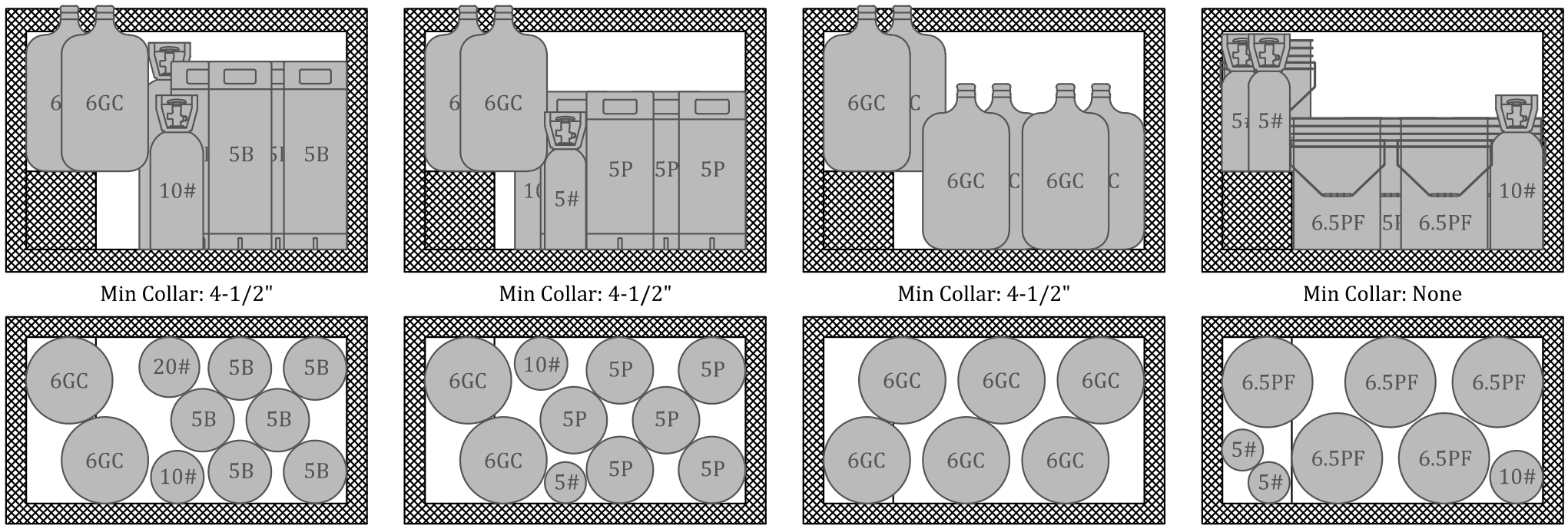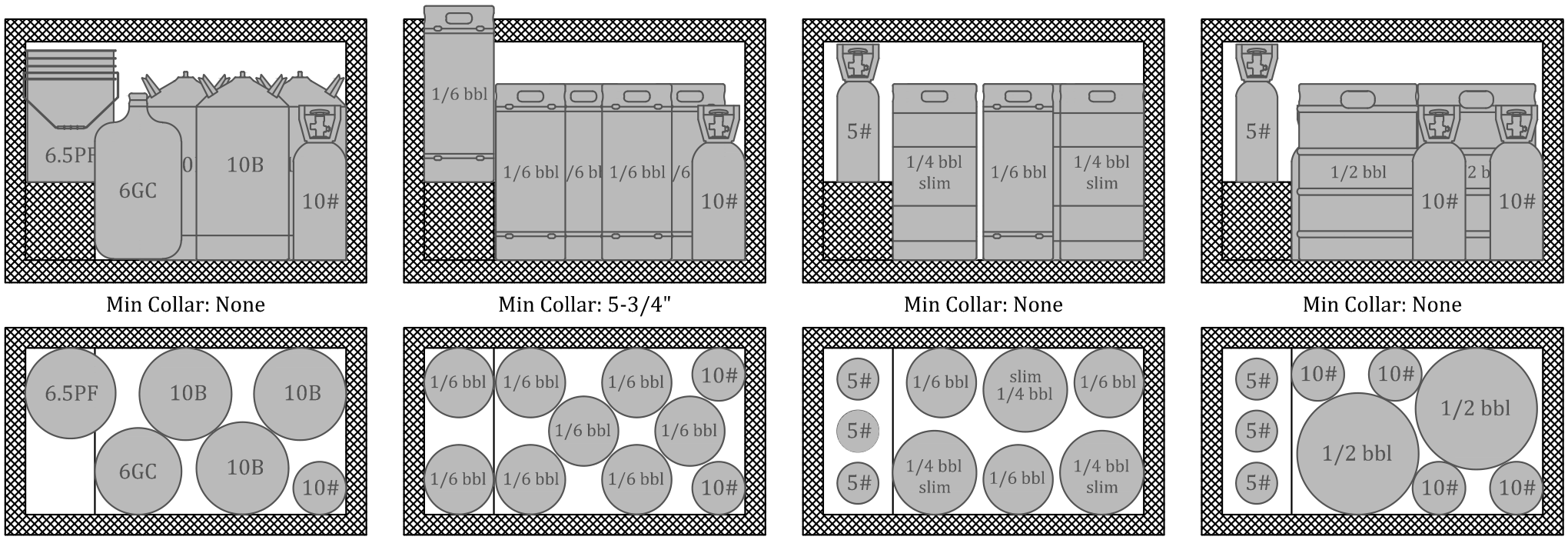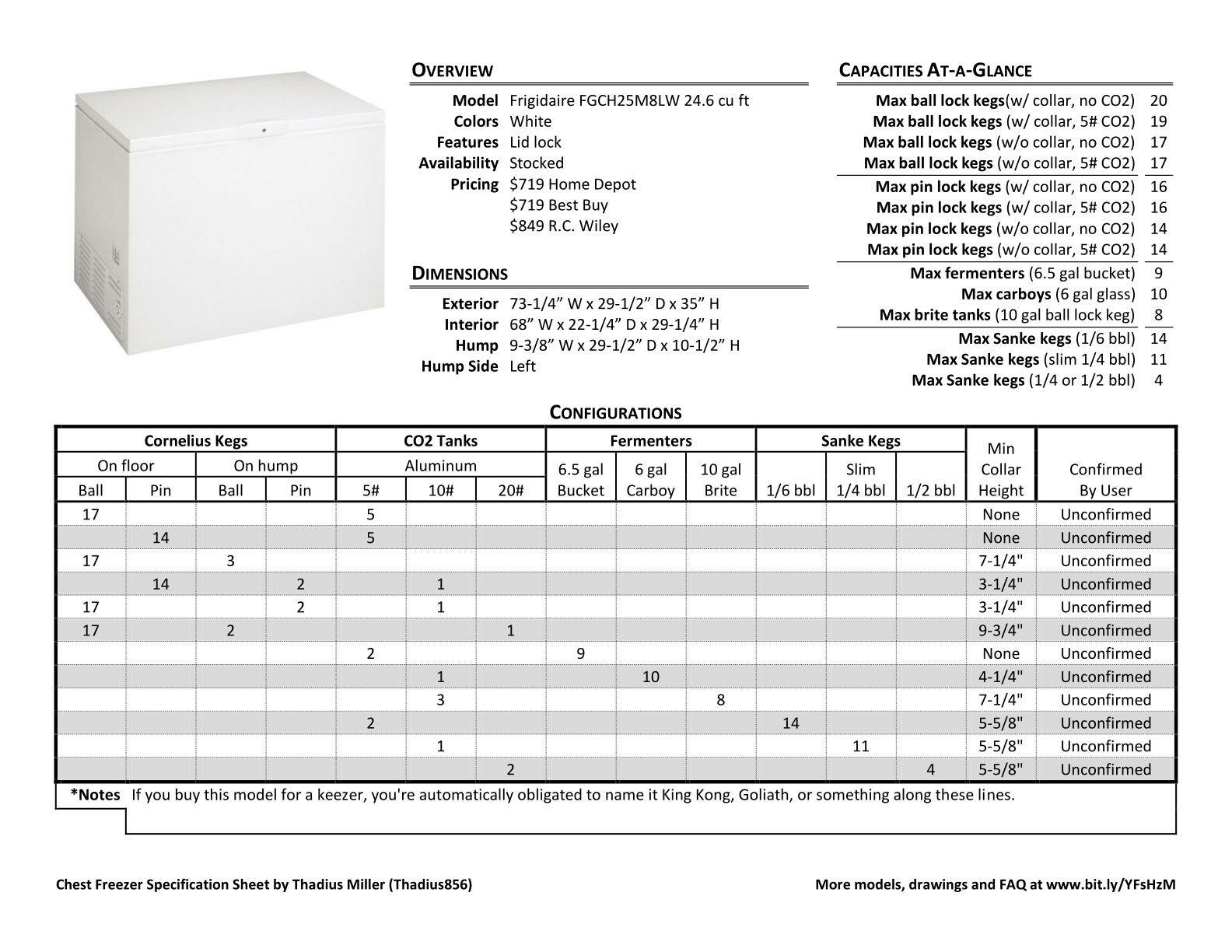Chest Freezer Specs Sheets and Layout Drawings
Like what you see? Click 'Like' at the bottom of this post!
Introduction
A little while back, I discovered the [thread=75449]Sizing your Chest Freezer for Corny Kegs[/thread] thread that inspired me to build a keezer and a fermentation chamber. I was blown away at how much information has been gathered to date on chest freezer models. Unfortunately, the thread has become increasingly disorganized as it has aged and, at over 60 pages, is unwieldy to browse. I found myself search for hours on hours just trying to determine which freezer could suit my needs (four kegs on the floor, fifth on the hump). As with many of my purchases, it resulted in a huge spreadsheet filled with numbers that I'll never look back at.
In an attempt to help the community here, I decided to utilize my CAD skills to help others vastly shorten their search to find the perfect chest freezer for them. To this end, I've created a specification sheet and layout drawings for several models of chest freezer so that their homebrew capabilities, prices and special features can be browsed on-the-fly. My goal is to gather, synthesize, and present these products for each of 30 models, ranging from 3.5 cu ft to 25 cu ft in capacity.
Progress: 21 models completed (67% to goal of 30) out of 52 known.
Please note that all of my images are clickable for a much larger view. I recommend you middle-click on them (click with the mouse wheel) to open them in another tab so you aren't navigated away from this page.
A Recommendation
I highly recommend that you read the next 4 posts before browsing through the specification sheet and layouts drawings. They will answer most of the questions that will arise while navigating this thread.
NOTE: Model names listed in bold have been completed. All other links simply point to placeholders.
Capacities At-a-Glance:
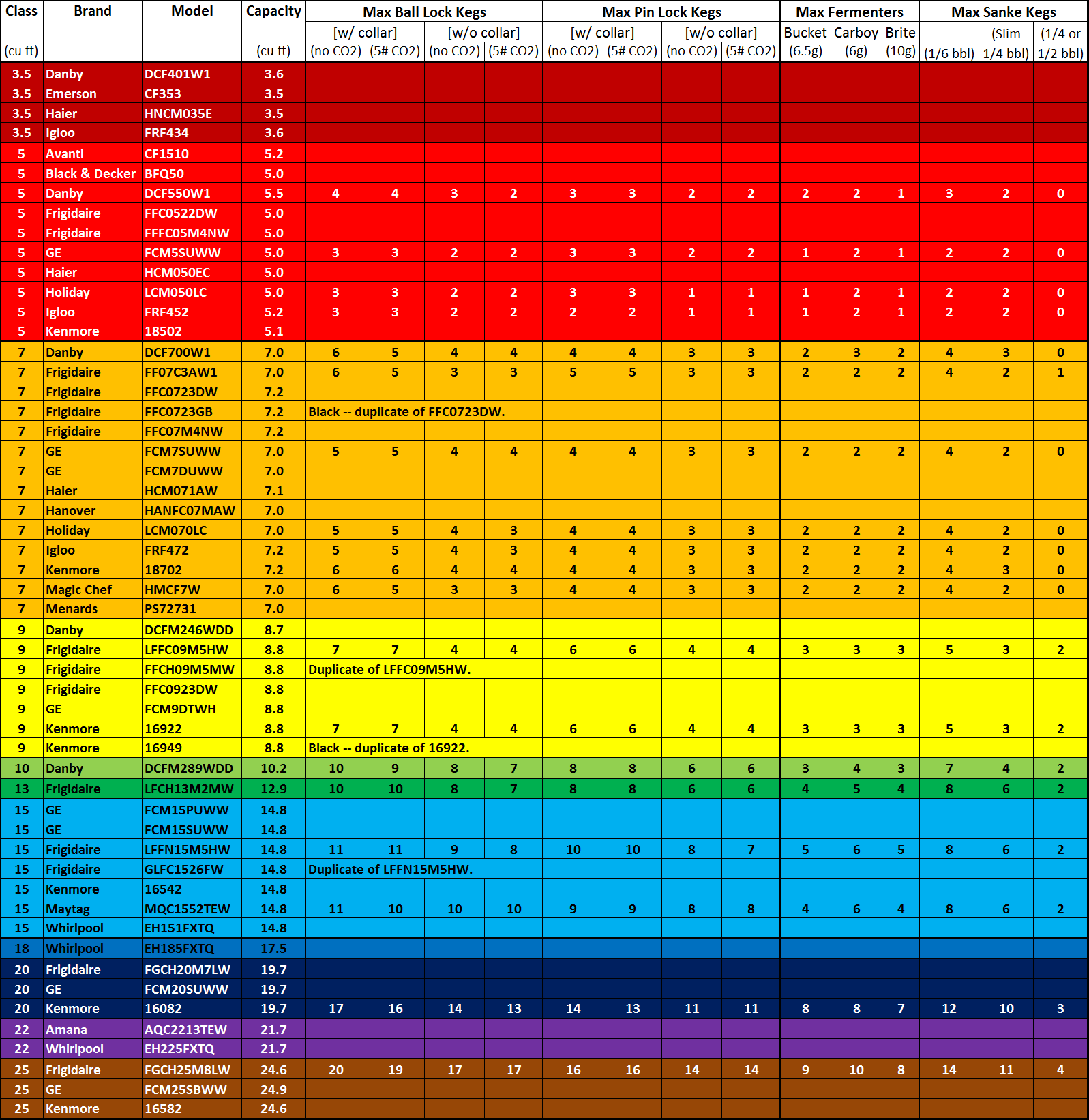
Spec Sheets and Layouts:
3.5 cu ft Class
[post=5115222]Danby 3.6 cu ft DCF401W1[/post]
[post=5115204]Emerson 3.5 cu ft CF353[/post]
[post=4731042]Haier 3.5 cu ft HNCM035E[/post]
[post=5131705]Igloo 3.6 cu ft FRF434[/post]
5 cu ft Class
[post=5115226]Avanti 5.2 cu ft CF1510[/post]
[post=5115209]Black & Decker 5.0 cu ft BFQ50[/post]
[post=4731047]Danby 5.5 cu ft DCF550W1[/post]
[post=5616618]Frigidaire 5.0 cu ft FFC0522DW[/post]
[post=5616620]Frigidaire 5.0 cu ft FFFC05M4NW[/post]
[post=4731043]GE 5.0 cu ft FCM5SUWW[/post]
[post=5115215]Haier 5.0 cu ft HCM050EC[/post]
[post=4731044]Holiday 5.0 cu ft LCM050LC[/post]
[post=4731045]Igloo 5.2 cu ft FRF452[/post]
[post=5616689]Kenmore 5.1 cu ft 18502[/post]
7 cu ft Class
[post=4731050]Danby 7.0 cu ft DCF700W1[/post]
[post=5038718]Frigidaire 7.0 cu ft FF07C3AW1[/post]
[post=5616141]Frigidaire 7.2 cu ft FF0723DW[/post]
[post=5616636]Frigidaire 7.2 cu ft FFC0723GB[/post]
[post=5616638]Frigidaire 7.2 cu ft FFC07M4NW[/post]
[post=4731051]GE 7.0 cu ft FCM7SUWW[/post]
[post=4731052]GE 7.0 cu ft FCM7DUWW[/post]
[post=4731056]Haier 7.1 cu ft HCM071AW[/post]
[post=4731053]Hanover 7.0 cu ft HANFC07MAW[/post]
[post=4731055]Holiday 7.0 cu ft LCM070LC[/post]
[post=4731057]Igloo 7.2 cu ft FRF472[/post]
[post=4906444]Kenmore 7.2 cu ft 18702[/post]
[post=4731048]Magic Chef 7.0 cu ft HMCF7W[/post]
[post=5616148]Menards 7.0 cu ft PS72731[/post]
9 cu ft Class
[post=4731058]Danby 8.7 cu ft DCFM246WDD[/post]
[post=4731060]Frigidaire 8.8 cu ft LFFC09M5HW[/post]
[post=5616660]Frigidaire 8.8 cu ft FFCH09M5MW[/post]
[post=5616622]Frigidaire 8.8 cu ft FFC0923DW[/post]
[post=4731059]GE 8.8 cu ft FCM9DTWH[/post]
[post=5616149]Kenmore 8.8 cu ft 16922[/post]
[post=5616681]Kenmore 8.8 cu ft 16949[/post]
10 cu ft Class
[post=4731061]Danby 10.2 cu ft DCFM289WDD[/post]
13 cu ft Class
[post=4731063]Frigidaire 12.9 cu ft LFCH13M2MW[/post]
15 cu ft Class
[post=4731069]Frigidaire 14.8 cu ft LFFN15M5HW[/post]
[post=5616792]Frigidaire 14.8 cu ft GLFC1526FW[/post]
[post=4731067]GE 14.8 cu ft FCM15PUWW[/post]
[post=4731068]GE 14.8 cu ft FCM15SUWW[/post]
Kenmore 14.8 cu ft 16542 Rebadged Frigidaire LFFN15M5HW
[post=4731064]Maytag 14.8 cu ft MQC1552TEW[/post]
[post=4731065]Whirlpool 14.8 cu ft EH151FXTQ[/post]
18 cu ft Class
[post=4731071]Whirlpool 17.5 cu ft EH185FXTQ[/post]
20.0 cu ft Class
[post=4731074]Frigidaire 19.7 cu ft FGCH20M7LW[/post]
[post=4731072]GE 19.7 cu ft FCM20SUWW[/post]
[post=5131691]Kenmore 19.7 cu ft 16082[/post]
22 cu ft Class
[post=4731077]Amana 21.7 cu ft AQC2213TEW[/post]
[post=4731090]Whirlpool 21.7 cu ft EH225FXTQ[/post]
25 cu ft Class
[post=4731092]Frigidaire 24.6 cu ft FGCH25M8LW[/post]
[post=4731091]GE 24.9 cu ft FCM25SBWW[/post]
[post=5616694]Kenmore 24.6 cu ft 16582[/post]
Like what you see? Click 'Like' at the bottom of this post!
Introduction
A little while back, I discovered the [thread=75449]Sizing your Chest Freezer for Corny Kegs[/thread] thread that inspired me to build a keezer and a fermentation chamber. I was blown away at how much information has been gathered to date on chest freezer models. Unfortunately, the thread has become increasingly disorganized as it has aged and, at over 60 pages, is unwieldy to browse. I found myself search for hours on hours just trying to determine which freezer could suit my needs (four kegs on the floor, fifth on the hump). As with many of my purchases, it resulted in a huge spreadsheet filled with numbers that I'll never look back at.
In an attempt to help the community here, I decided to utilize my CAD skills to help others vastly shorten their search to find the perfect chest freezer for them. To this end, I've created a specification sheet and layout drawings for several models of chest freezer so that their homebrew capabilities, prices and special features can be browsed on-the-fly. My goal is to gather, synthesize, and present these products for each of 30 models, ranging from 3.5 cu ft to 25 cu ft in capacity.
Progress: 21 models completed (67% to goal of 30) out of 52 known.
Please note that all of my images are clickable for a much larger view. I recommend you middle-click on them (click with the mouse wheel) to open them in another tab so you aren't navigated away from this page.
A Recommendation
I highly recommend that you read the next 4 posts before browsing through the specification sheet and layouts drawings. They will answer most of the questions that will arise while navigating this thread.
NOTE: Model names listed in bold have been completed. All other links simply point to placeholders.
Capacities At-a-Glance:

Spec Sheets and Layouts:
3.5 cu ft Class
[post=5115222]Danby 3.6 cu ft DCF401W1[/post]
[post=5115204]Emerson 3.5 cu ft CF353[/post]
[post=4731042]Haier 3.5 cu ft HNCM035E[/post]
[post=5131705]Igloo 3.6 cu ft FRF434[/post]
5 cu ft Class
[post=5115226]Avanti 5.2 cu ft CF1510[/post]
[post=5115209]Black & Decker 5.0 cu ft BFQ50[/post]
[post=4731047]Danby 5.5 cu ft DCF550W1[/post]
[post=5616618]Frigidaire 5.0 cu ft FFC0522DW[/post]
[post=5616620]Frigidaire 5.0 cu ft FFFC05M4NW[/post]
[post=4731043]GE 5.0 cu ft FCM5SUWW[/post]
[post=5115215]Haier 5.0 cu ft HCM050EC[/post]
[post=4731044]Holiday 5.0 cu ft LCM050LC[/post]
[post=4731045]Igloo 5.2 cu ft FRF452[/post]
[post=5616689]Kenmore 5.1 cu ft 18502[/post]
7 cu ft Class
[post=4731050]Danby 7.0 cu ft DCF700W1[/post]
[post=5038718]Frigidaire 7.0 cu ft FF07C3AW1[/post]
[post=5616141]Frigidaire 7.2 cu ft FF0723DW[/post]
[post=5616636]Frigidaire 7.2 cu ft FFC0723GB[/post]
[post=5616638]Frigidaire 7.2 cu ft FFC07M4NW[/post]
[post=4731051]GE 7.0 cu ft FCM7SUWW[/post]
[post=4731052]GE 7.0 cu ft FCM7DUWW[/post]
[post=4731056]Haier 7.1 cu ft HCM071AW[/post]
[post=4731053]Hanover 7.0 cu ft HANFC07MAW[/post]
[post=4731055]Holiday 7.0 cu ft LCM070LC[/post]
[post=4731057]Igloo 7.2 cu ft FRF472[/post]
[post=4906444]Kenmore 7.2 cu ft 18702[/post]
[post=4731048]Magic Chef 7.0 cu ft HMCF7W[/post]
[post=5616148]Menards 7.0 cu ft PS72731[/post]
9 cu ft Class
[post=4731058]Danby 8.7 cu ft DCFM246WDD[/post]
[post=4731060]Frigidaire 8.8 cu ft LFFC09M5HW[/post]
[post=5616660]Frigidaire 8.8 cu ft FFCH09M5MW[/post]
[post=5616622]Frigidaire 8.8 cu ft FFC0923DW[/post]
[post=4731059]GE 8.8 cu ft FCM9DTWH[/post]
[post=5616149]Kenmore 8.8 cu ft 16922[/post]
[post=5616681]Kenmore 8.8 cu ft 16949[/post]
10 cu ft Class
[post=4731061]Danby 10.2 cu ft DCFM289WDD[/post]
13 cu ft Class
[post=4731063]Frigidaire 12.9 cu ft LFCH13M2MW[/post]
15 cu ft Class
[post=4731069]Frigidaire 14.8 cu ft LFFN15M5HW[/post]
[post=5616792]Frigidaire 14.8 cu ft GLFC1526FW[/post]
[post=4731067]GE 14.8 cu ft FCM15PUWW[/post]
[post=4731068]GE 14.8 cu ft FCM15SUWW[/post]
Kenmore 14.8 cu ft 16542 Rebadged Frigidaire LFFN15M5HW
[post=4731064]Maytag 14.8 cu ft MQC1552TEW[/post]
[post=4731065]Whirlpool 14.8 cu ft EH151FXTQ[/post]
18 cu ft Class
[post=4731071]Whirlpool 17.5 cu ft EH185FXTQ[/post]
20.0 cu ft Class
[post=4731074]Frigidaire 19.7 cu ft FGCH20M7LW[/post]
[post=4731072]GE 19.7 cu ft FCM20SUWW[/post]
[post=5131691]Kenmore 19.7 cu ft 16082[/post]
22 cu ft Class
[post=4731077]Amana 21.7 cu ft AQC2213TEW[/post]
[post=4731090]Whirlpool 21.7 cu ft EH225FXTQ[/post]
25 cu ft Class
[post=4731092]Frigidaire 24.6 cu ft FGCH25M8LW[/post]
[post=4731091]GE 24.9 cu ft FCM25SBWW[/post]
[post=5616694]Kenmore 24.6 cu ft 16582[/post]





